The recent resurgence of Art Deco has little to do with nostalgia and everything to do with its confident geometry, glamorous materials, and mix-of-metals shine that feel unexpectedly fresh in 2025 homes. Designers are pairing the style’s hallmark symmetry with contemporary silhouettes and sustainable finishes, proving its versatility beyond period properties. Whether you’re starting from scratch or simply swapping in a statement fixture, an Art Deco dining room can turn every meal into an occasion. Ready to let streamlined curves and bold pattern elevate your gatherings? Let the following ideas spark your imagination.
1. Geometric Ceiling Molding Elevates the Art Deco Dining Room
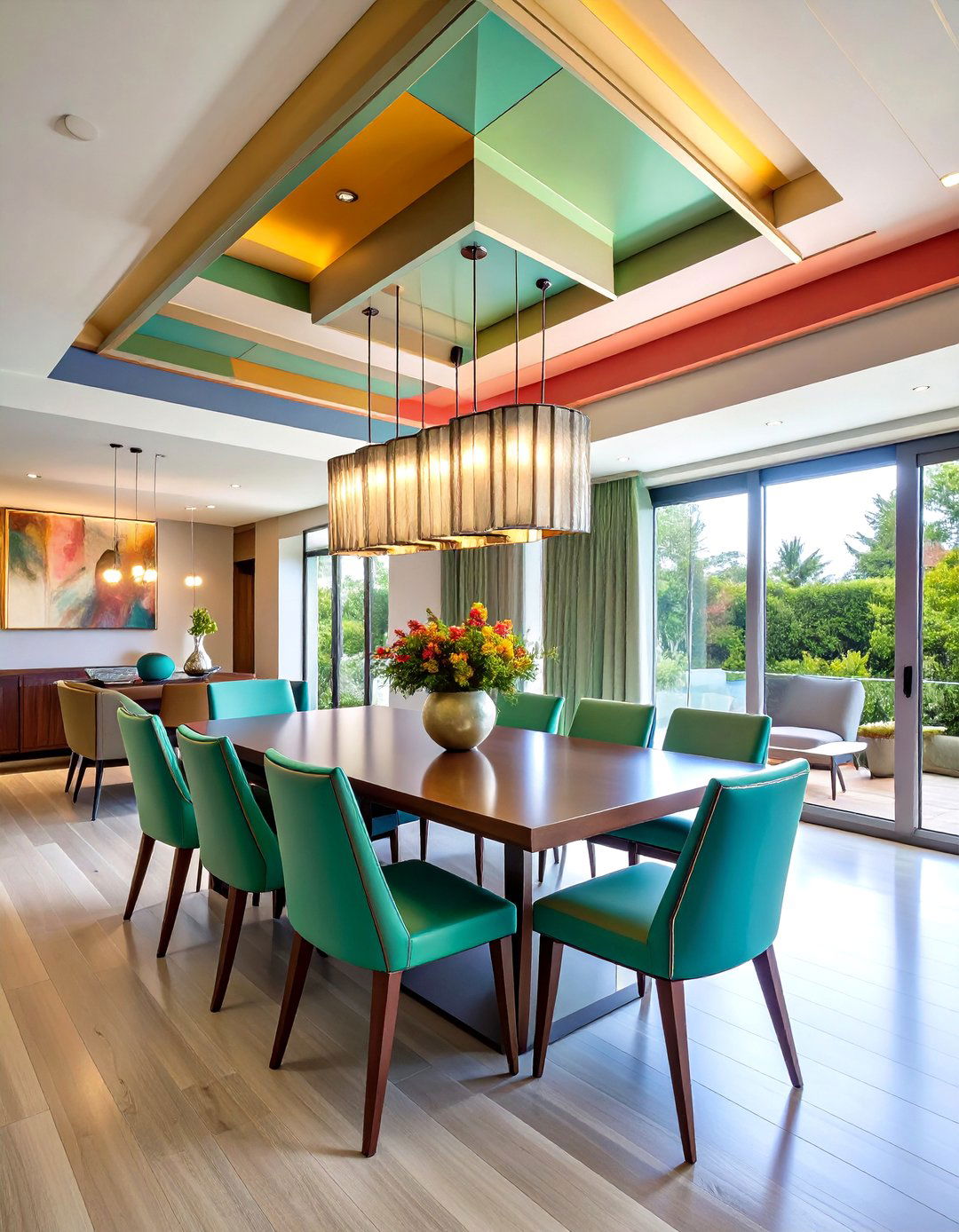
A crisp, stepped ceiling instantly declares an Art Deco dining room’s intentions. Echo the era’s fascination with skyscrapers by installing layered crown molding that ascends toward the center like a ziggurat. Paint the tiers a single matte hue so shadows do the talking, or highlight each plane with a subtle metallic stripe for extra dimension. Because the treatment sits overhead, it leaves wall space free for artwork while still loading the room with character. Match the geometry below by choosing a table with chamfered corners or an octagonal top to reinforce the upward rhythm.
2. Sunburst Chandelier as Show-Stopping Centerpiece
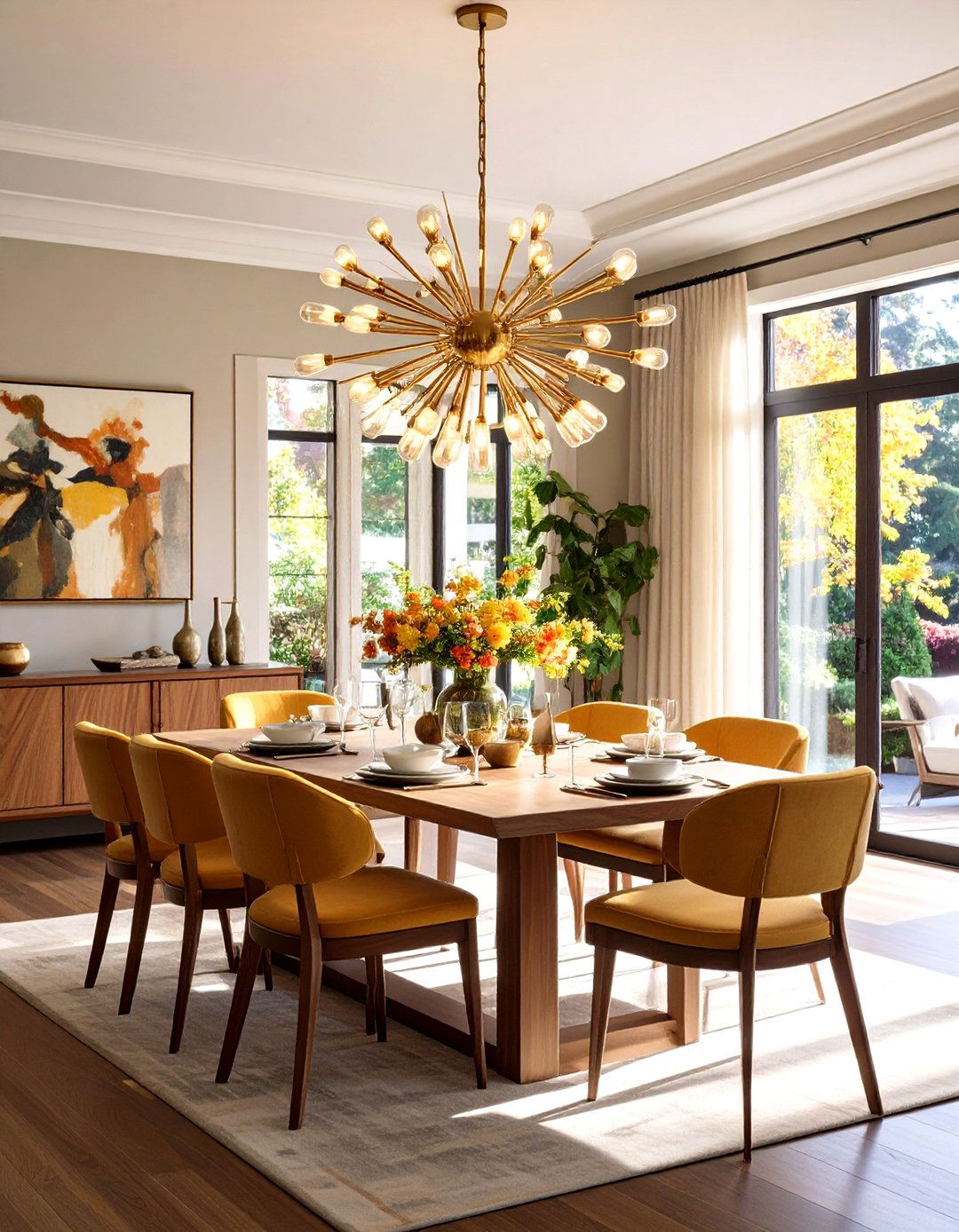
The moment guests glance upward at a gleaming sunburst fixture, they’ll recognize your dining room’s Art Deco heartbeat. Opt for brass or gilt spokes radiating from an opal-glass core to scatter warm light across plates and conversation alike. A dimmer switch keeps the sparkle adjustable, while bulbs on staggered stems prevent glare. Balance the ceiling drama with streamlined chairs so the light remains the star. When ceilings are low, choose a flush-mount design that fans out horizontally; lofty rooms can handle elongated pendants that echo vintage movie-palace glamour.
3. Mirror-Backed Buffet Doubles the Deco Impact
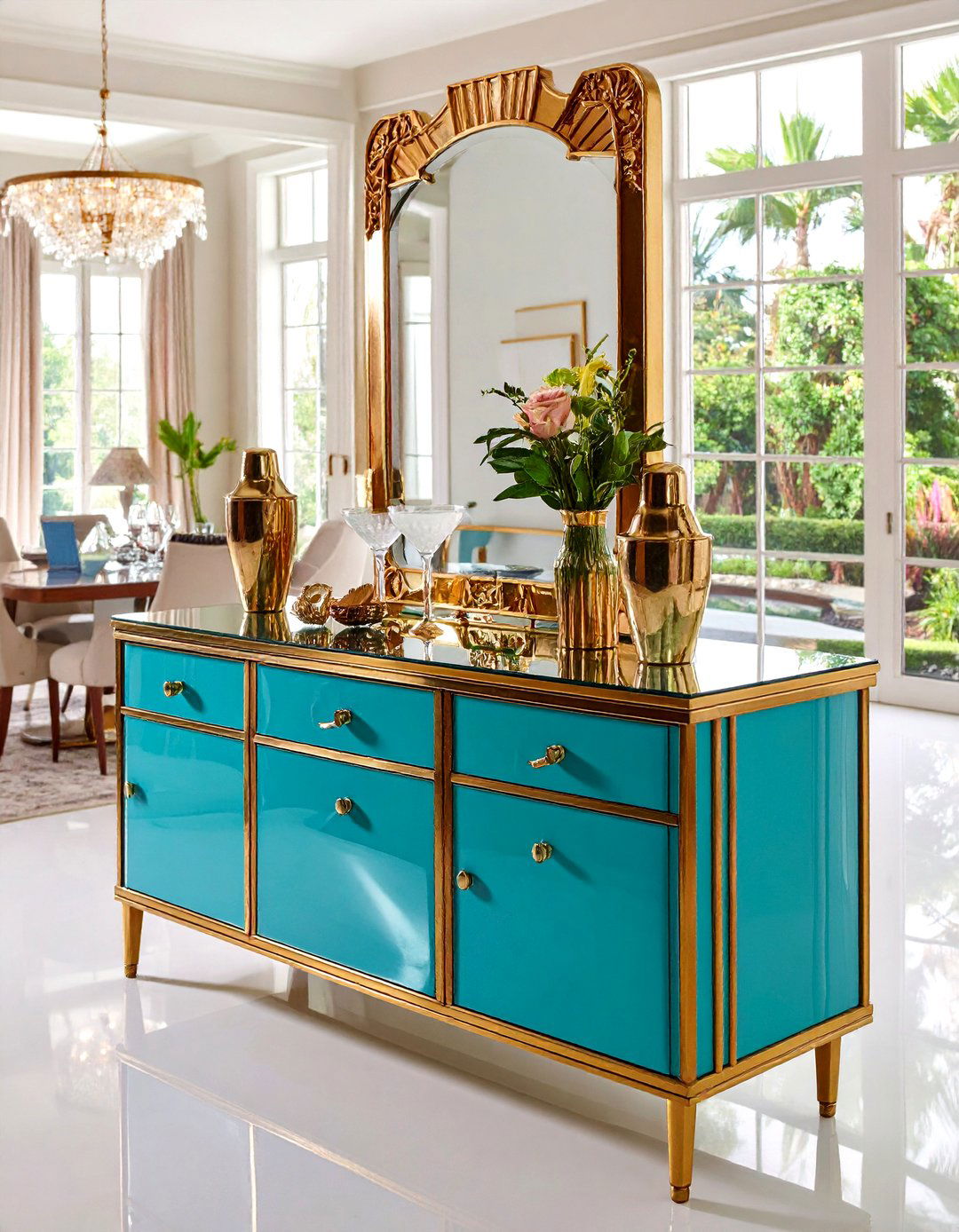
Unlike ordinary storage, a mirrored buffet multiplies color, candlelight, and crystal in a single sleek gesture. Fit antiqued glass to cabinet fronts or line the backsplash of a built-in sideboard to bounce brightness across the dining room. Thin chrome trim around each panel reinforces Art Deco’s love of reflection without tipping into kitsch. Inside, velvet-lined drawers cradle flatware, keeping everyday function intact. Finish the vignette with a sculptural ice bucket or martini shaker atop the surface so the mirror can spotlight every metallic detail.
4. Jewel-Tone Velvet Chairs Bring Luxe Comfort
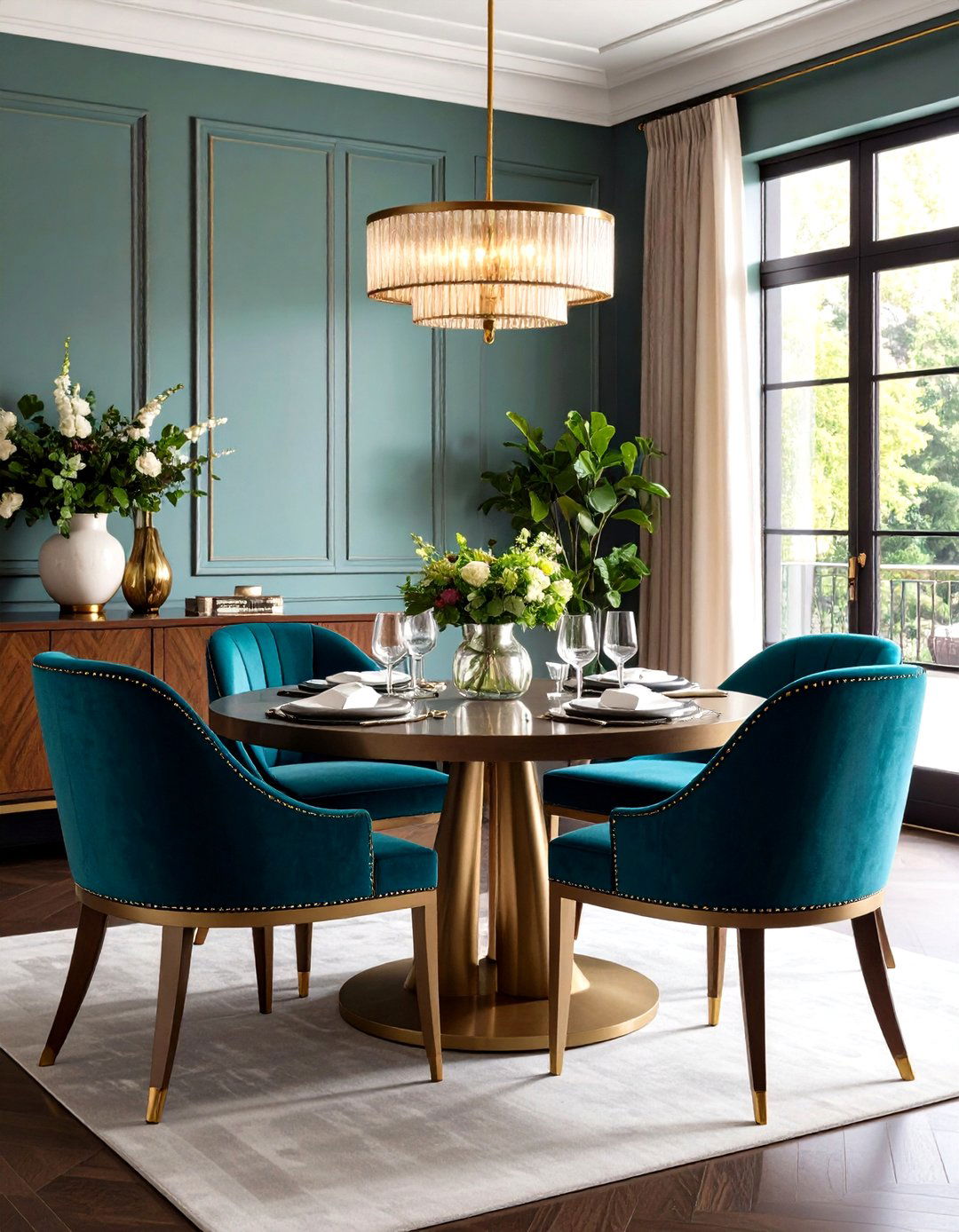
To usher guests into plush comfort worthy of a Jazz-Age supper club, upholster dining chairs in emerald, sapphire, or ruby velvet. The saturated colors amplify Art Deco exuberance and hide minor stains better than pale fabrics. Opt for a tight, rounded back that cocoons the sitter, then outline the silhouette with nail-head trim or slim piping for tailored polish. If your palette leans neutral, a single pair of colored host chairs at the ends of the table still delivers excitement without overwhelming the scheme.
5. Bold Geometric Rug Grounds the Room
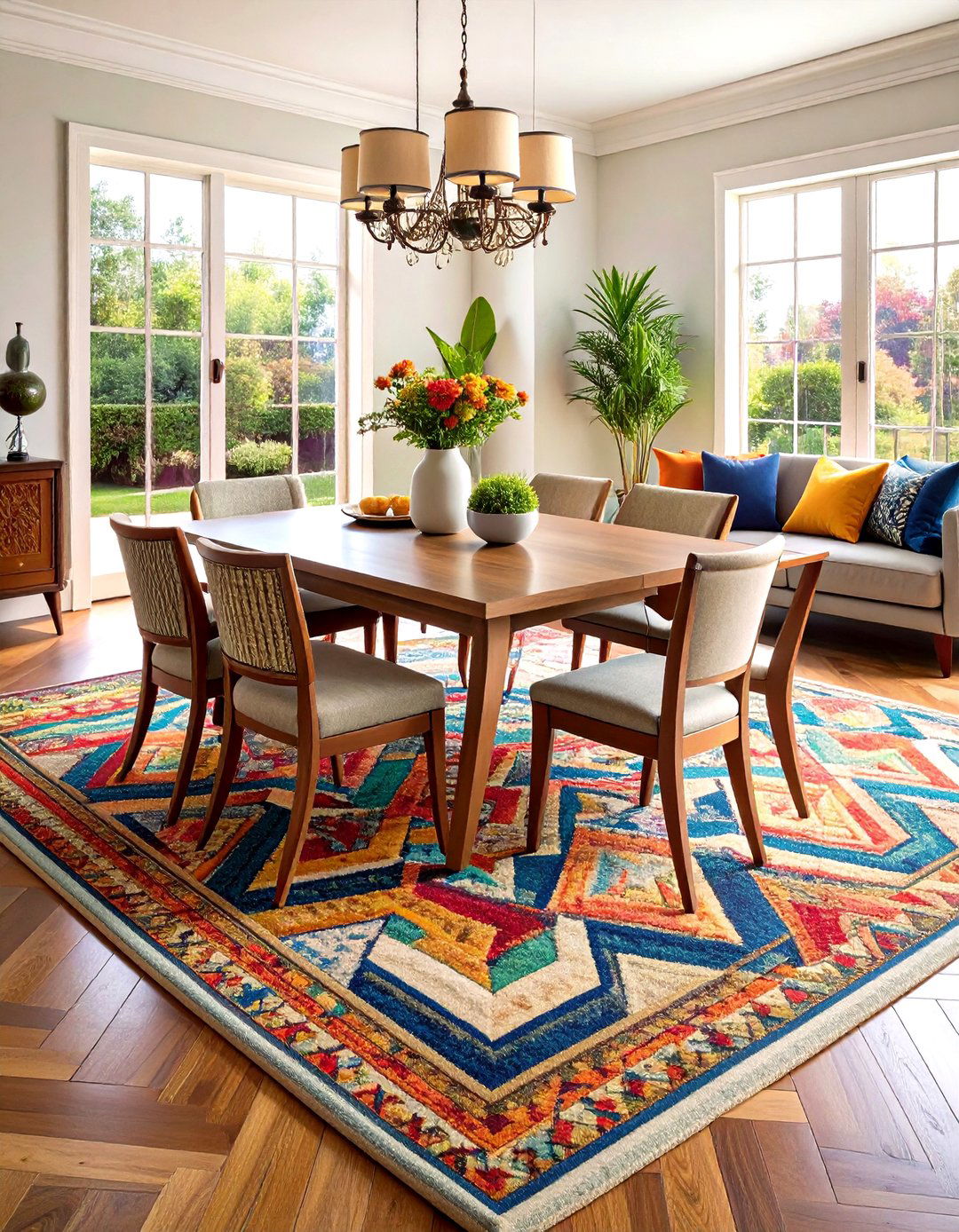
Studies show pattern underfoot can visually unify scattered furnishings, and nowhere is that more evident than with a rug flashing chevrons, scallops, or Greek-key lines straight from 1920s Paris.
edwardgeorgelondon.com
Choose fibers in low-pile wool for durability, and ensure the design’s darkest tones echo your dining table finish so the whole composition feels intentional. Keep surrounding textiles solid so the floor earns the spotlight, or layer a subtler tone-on-tone rug beneath a glass table for a quieter take on the motif.
6. Lacquered Dining Table Reflects the Glamour
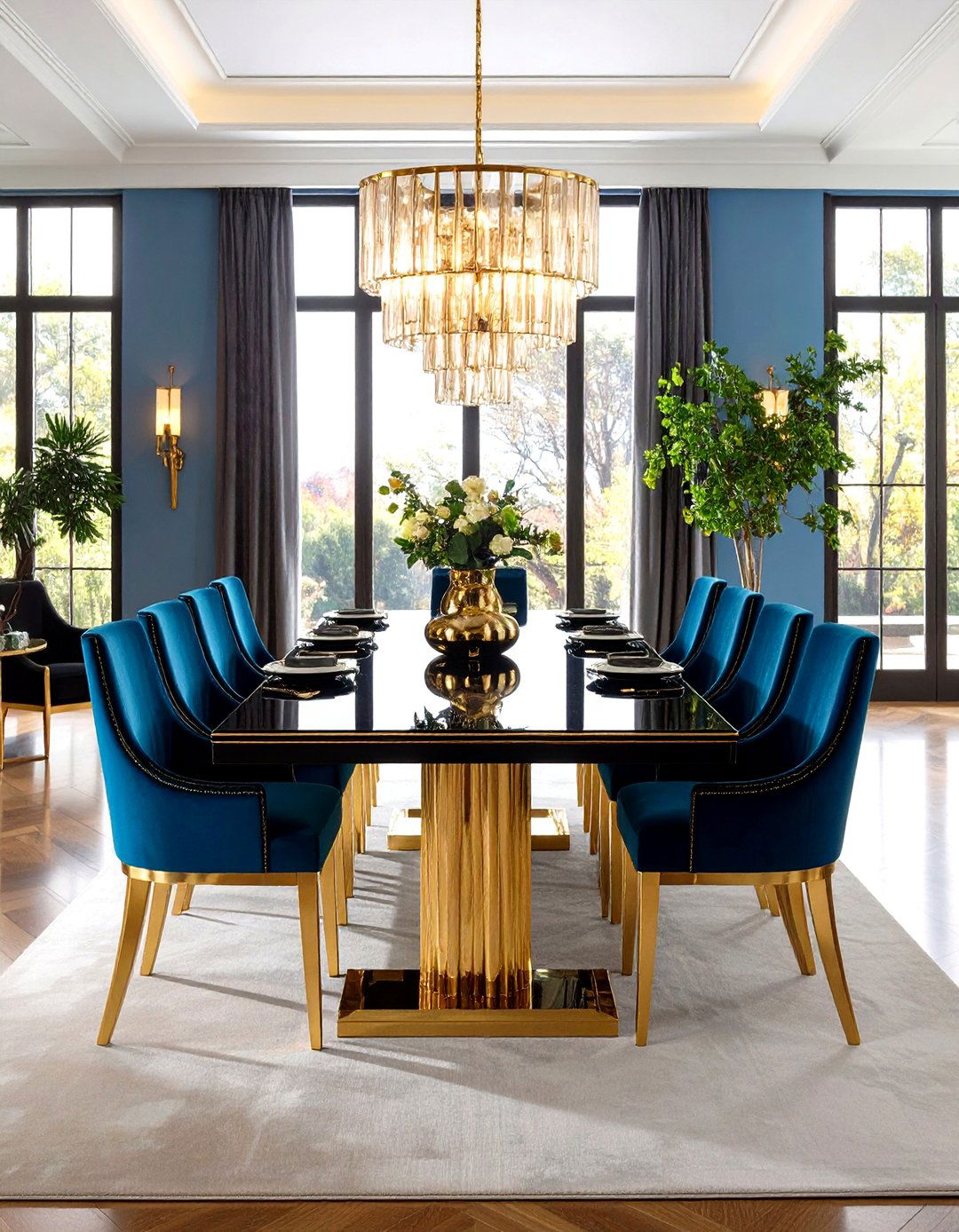
What better stage for conversation than a glossy tabletop that mirrors candlelight? Modern high-pressure lacquers provide the famous Art Deco sheen without the fussy upkeep of vintage shellac. A rectangular silhouette with clipped corners references old-school steamliners, while a round option invites longer lingering. If a new table isn’t in the budget, consider professional refinishing: even a thrifted piece can achieve piano-like shine with careful sanding and multiple clear coats.
7. Brass-and-Chrome Mix Adds Period Authenticity

Surprisingly, mixing brass and chrome doesn’t read chaotic; the combination is signature Art Deco. Use soft brushed brass on hardware or chair legs, then introduce cool chrome in lighting arms or picture frames to create the push-and-pull that defined 1930s luxury liners. Maintain cohesion by sticking to streamlined shapes—think straight rods, thin rings, and geometric pulls—so the metal contrast feels curated, not random.
8. Streamlined Banquette Seating Maximizes Space
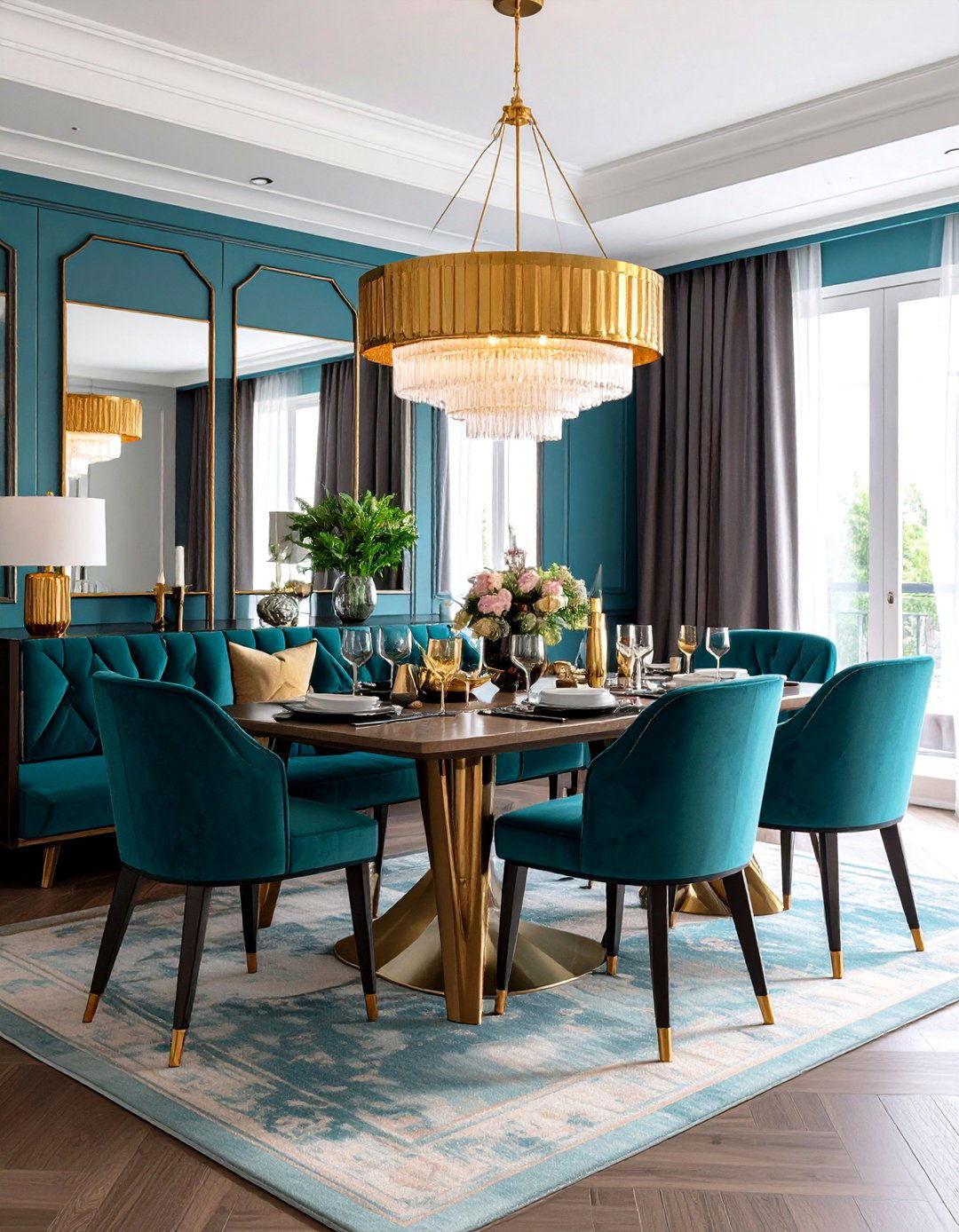
Consider wrapping one or two walls with a tight, upholstered banquette to channel the intimate mood of a vintage train car. A tufted back in durable performance velvet invites lengthy dinners, while hidden drawers beneath the seat corral linens. Pair with pedestal tables so diners slide in and out easily. Because a banquette’s footprint is shallower than standalone chairs, it’s a smart solution for narrow dining rooms yearning for Art Deco flair.
9. Black-and-Gold Palette Delivers Instant Drama
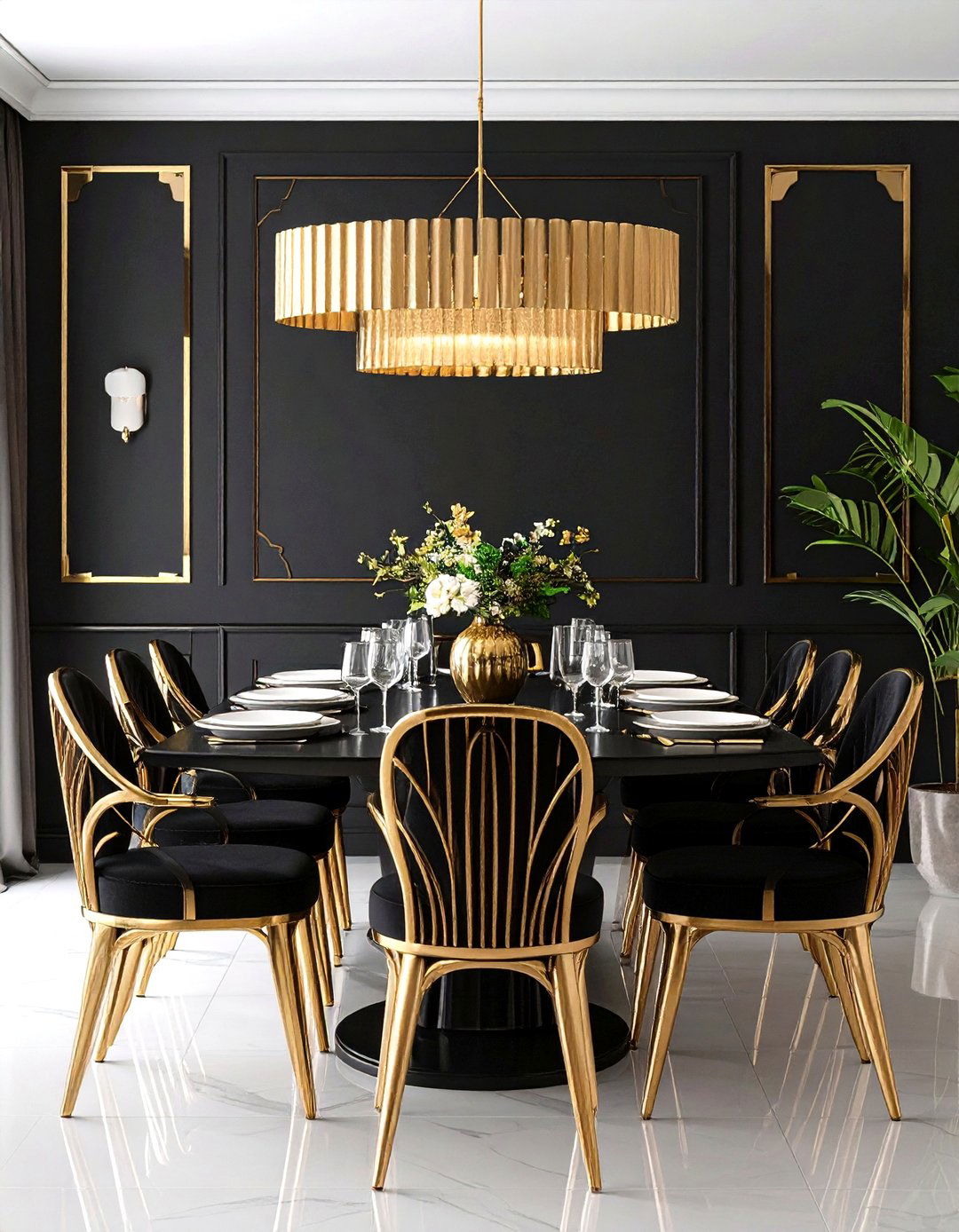
With, perhaps, the boldest contrast in design, a matte black wall flanked by gold accents sets a moody yet luxurious stage. Paint only the lower two-thirds of the wall in charcoal and add a slim brass chair rail to lighten the boundary—a trick that prevents the room from feeling cavernous. Layer in alabaster plates and pale linens on the table top so meals gleam against the dark backdrop rather than disappear.
10. Curved Bar Cart Keeps Cocktails Handy
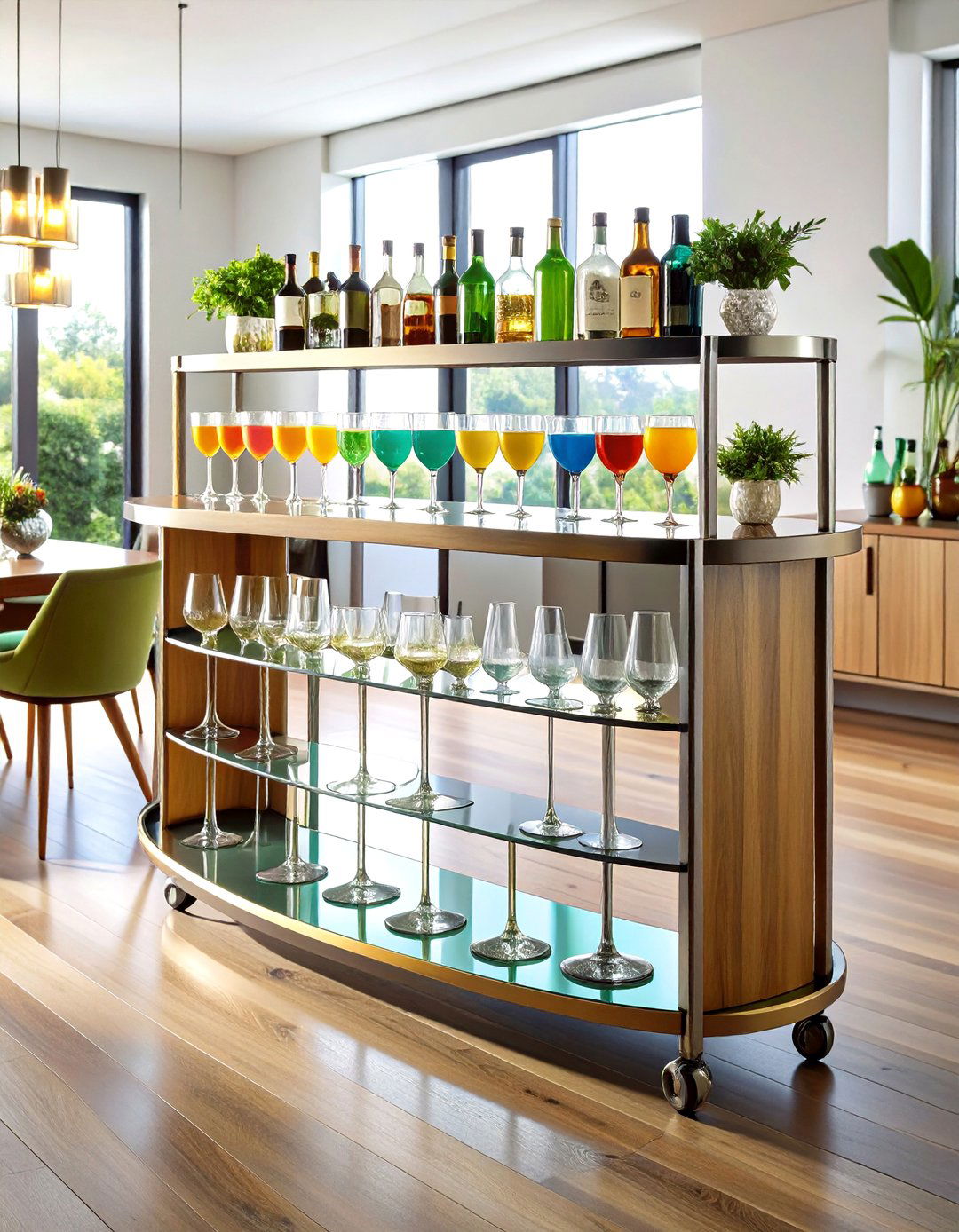
To reference the social whirl of the Roaring Twenties, roll out a metal-rimmed bar cart with semicircular shelves. The soft arc counters the dining table’s hard edges and prevents bruised shins in tight quarters. Look for mirrored shelves or smoked-glass tiers that showcase crystal decanters while contributing extra sparkle. Between meals, the cart moonlights as a dessert station or plant perch, earning its square footage in multitasking style.
11. Graphic Wallpaper Creates a Statement Wall
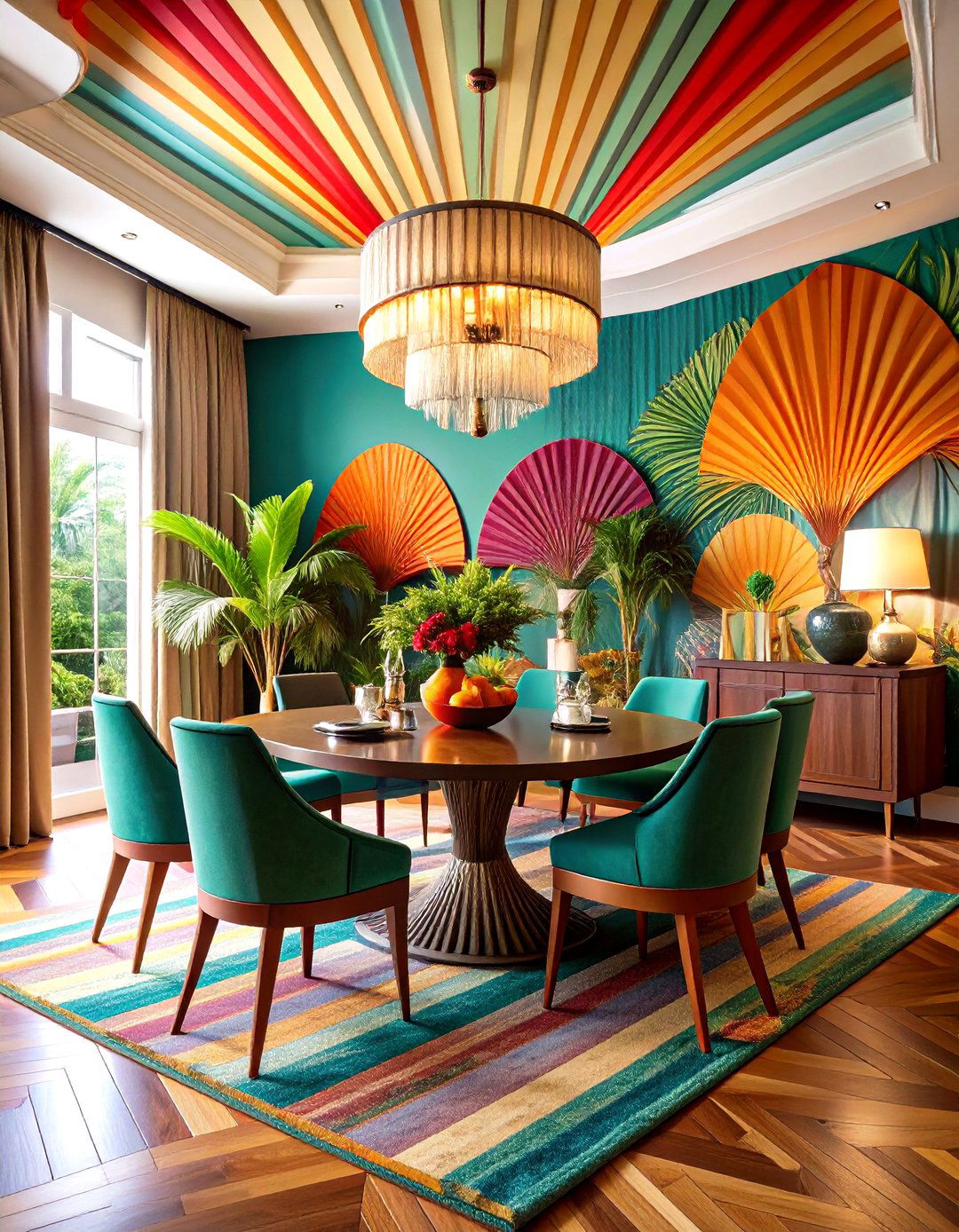
Another option for punch without permanent construction is wallpaper boasting oversized fans, zigzags, or stylized palms reminiscent of Miami’s seaside hotels. Peel-and-stick offerings make it renter-friendly; grass-cloth versions add tactile richness for homeowners. Keep coverage to one wall if the pattern feels intense, and repeat a single motif color in seat cushions or window trim so the dining room reads cohesive rather than chaotic.
12. Symmetry-Focused Furniture Layout Feels Balanced

Architects of the Art Deco period prized balance, and you can echo that by arranging furnishings along a central axis—buffet directly opposite a fireplace, identical sconces flanking artwork, chairs paired rather than mixed. Symmetry calms the eye, letting notable materials shine. If perfect mirroring isn’t feasible, create visual pairs through color: two different sideboards painted the same lacquered hue still satisfy the brain’s craving for order.
13. Layered Lighting Adds Nighttime Drama
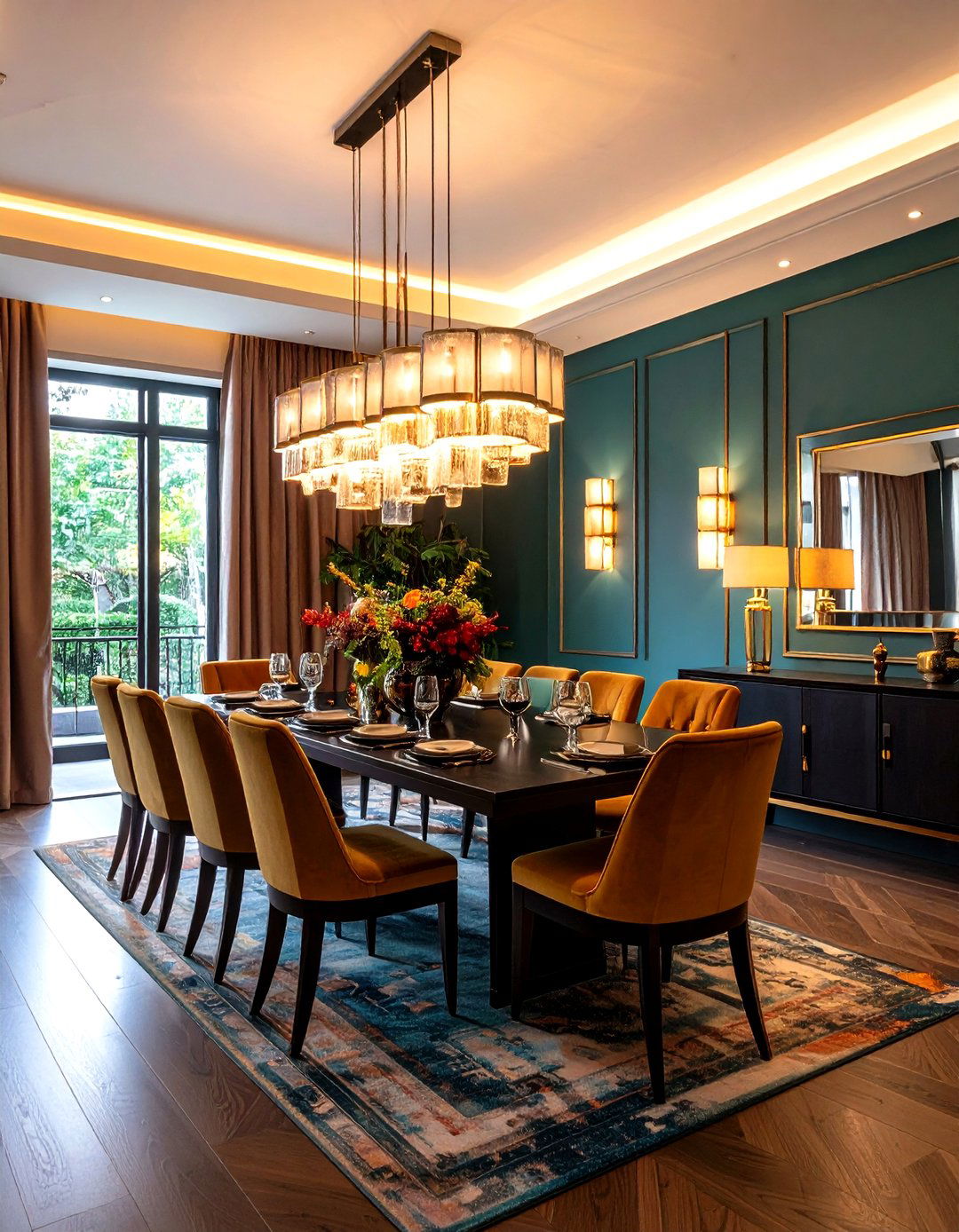
Certainly the quickest way to evoke Deco glamour is by combining a central chandelier with wall sconces, cove LEDs, and even illuminated display shelves. Each layer operates on separate dimmers, so the dining room shifts from bright brunch to sultry supper with a twist. Choose frosted glass or alabaster shades that soften light and reference period fixtures; then tuck LED tape beneath buffets to create an unexpected glow along the floor plane.
14. Sculptural Screens Define Space Gracefully
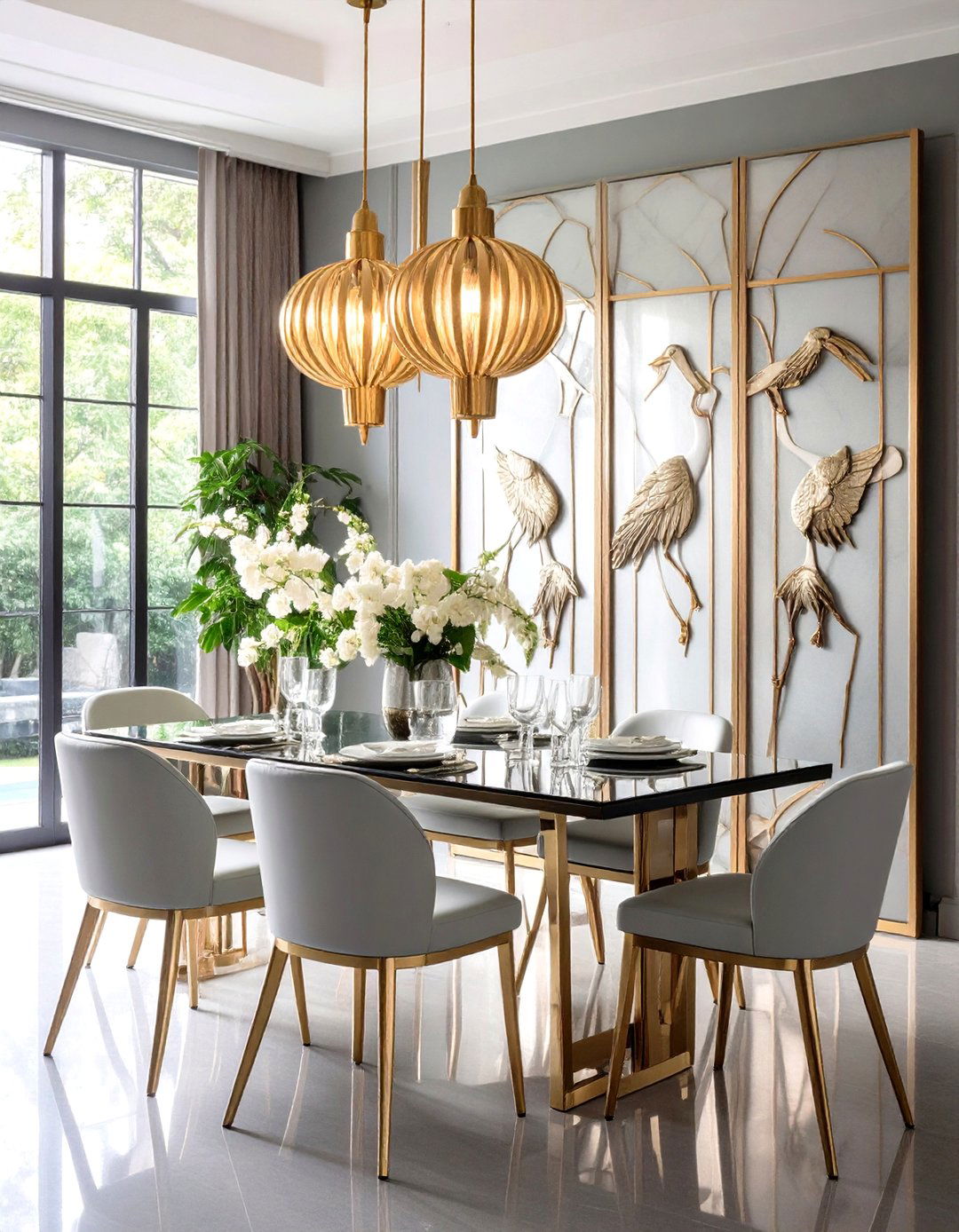
An Art Deco folding screen—perhaps painted with stylized cranes or finished in silver leaf—can portion open-plan layouts without erecting true walls. Position the screen to buffer traffic from a hallway or hide a workspace when entertaining. Hinged panels fold nearly flat when not required, and their height draws the eye upward, enhancing any coffered ceilings or chandeliers you’ve installed.
15. Glamorous Tableware Display Personalizes the Room
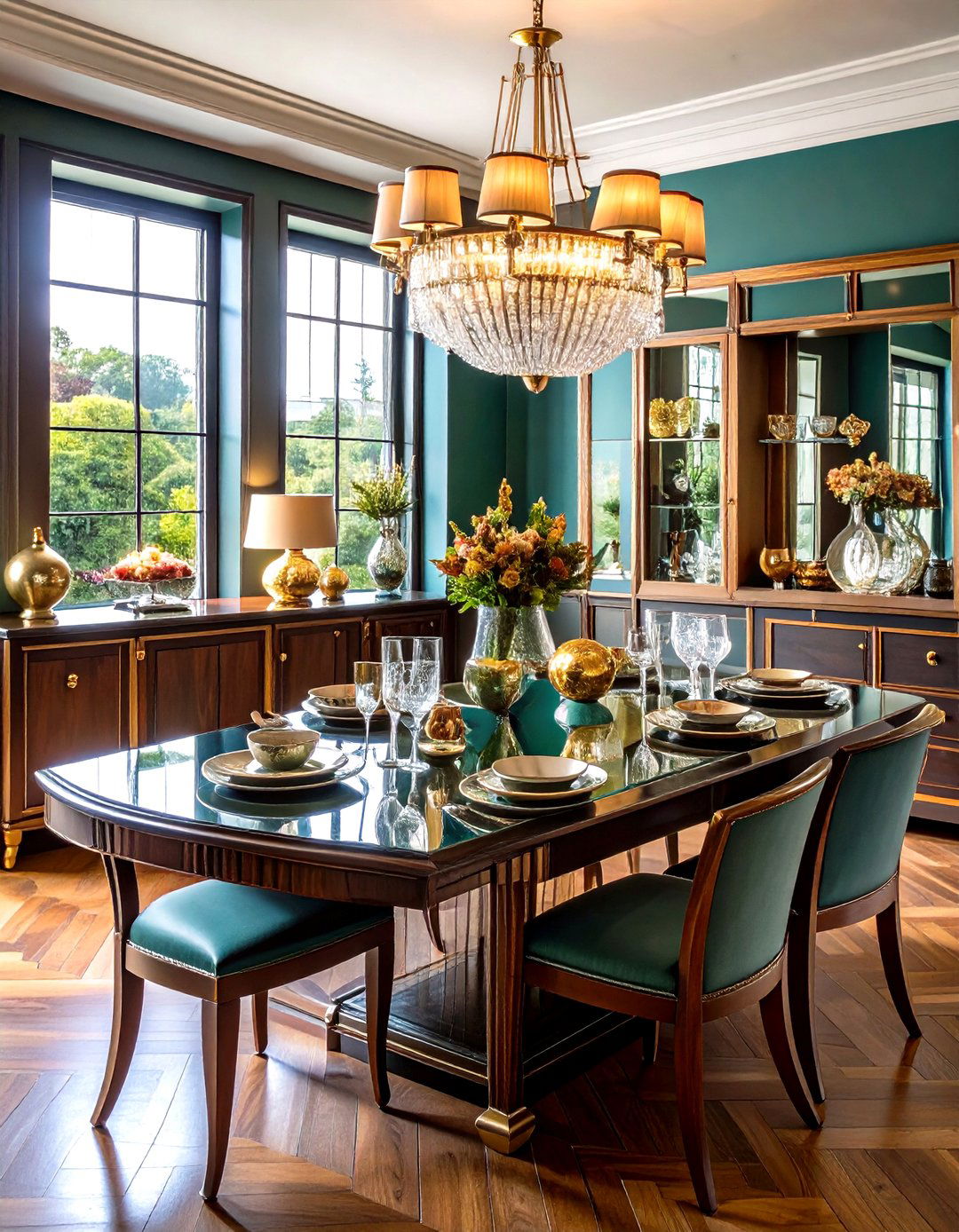
Owing to their sleek silhouettes, Deco-era china cabinets make glorious stage sets for gleaming stemware, faceted glass decanters, and black-and-white dinner plates. Swap solid cabinet backs for mirrors or paint them a contrasting jewel tone so collectibles pop. Rotate contents seasonally—crystal punch bowl in winter, iridescent vases in spring—to keep the dining room feeling curated rather than cluttered.
16. Exotic Wood Inlay Adds Depth
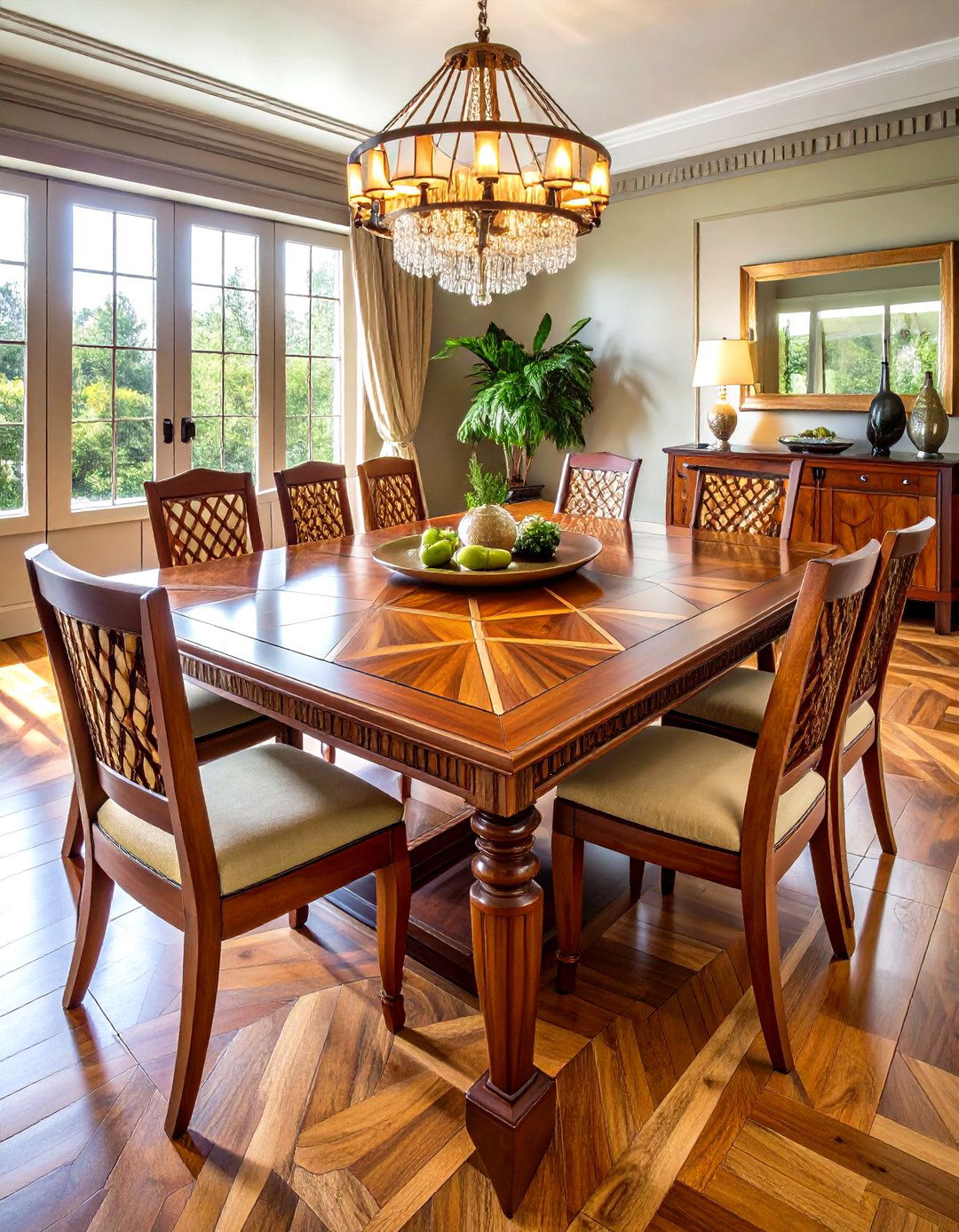
Mahogany banded with ebony or a walnut tabletop sporting maple chevrons embodies the craftsmanship of early twentieth-century ateliers. If commissioning bespoke furniture exceeds your budget, consider veneered chargers or placemats etched with geometric marquetry patterns—little hits of exotic wood can still broadcast authenticity without requiring a mortgage. Seal surfaces well; inlays are beautiful but sensitive to heat and moisture.
17. Floor-to-Ceiling Drapery Softens Geometry
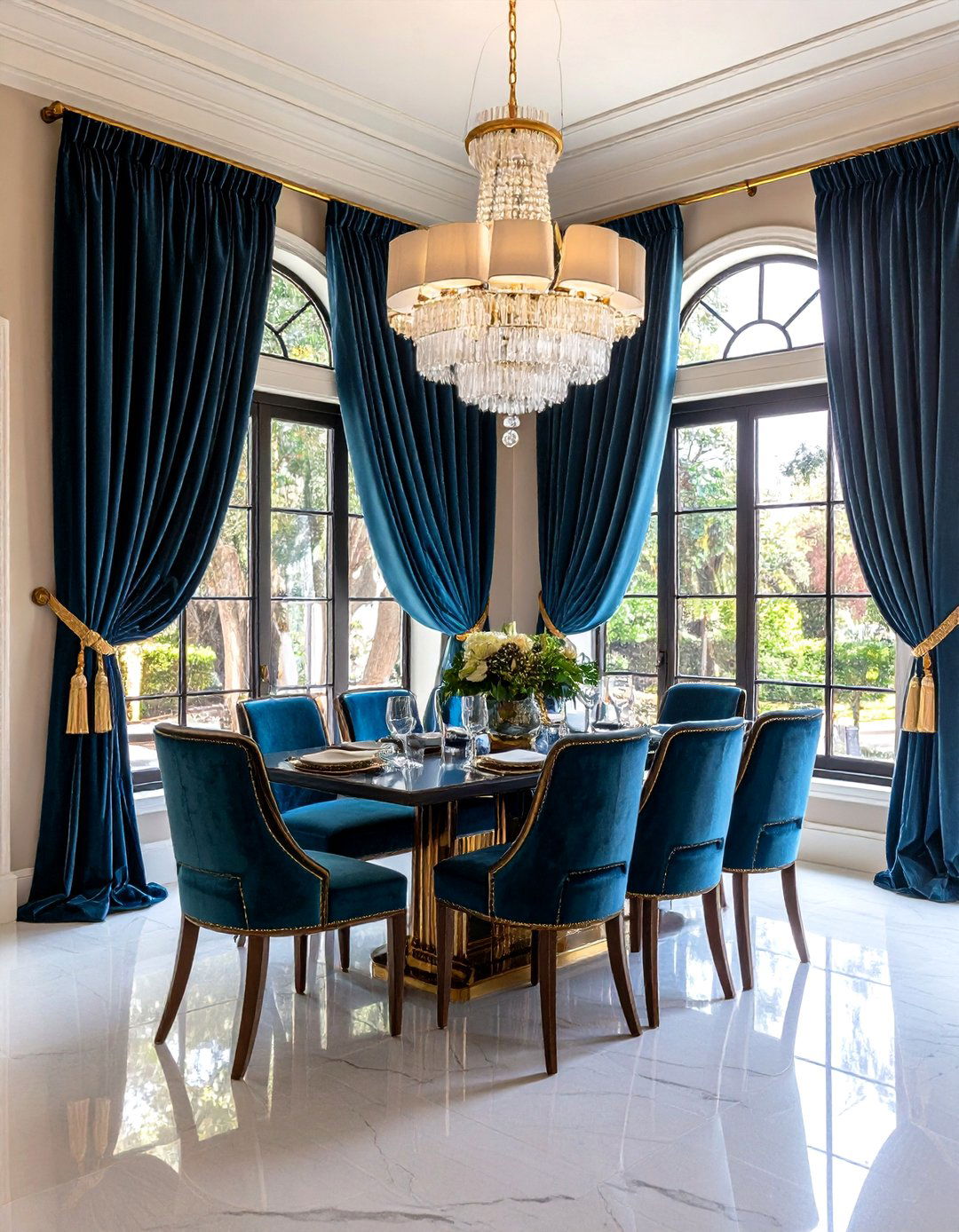
Although Art Deco celebrates strong lines, ultra-tall curtains in velvet or silk-blend fabric temper edges and improve acoustics. Install rods close to the ceiling to exaggerate height, and choose geometric tiebacks—perhaps a slim brass circle—to echo motifs elsewhere. Lining curtains with blackout fabric not only enhances drape but also protects delicate textiles from sunlight, ensuring their jewel tones stay vibrant for years.
18. Patterned Terrazzo Flooring Channels Streamlined Luxury
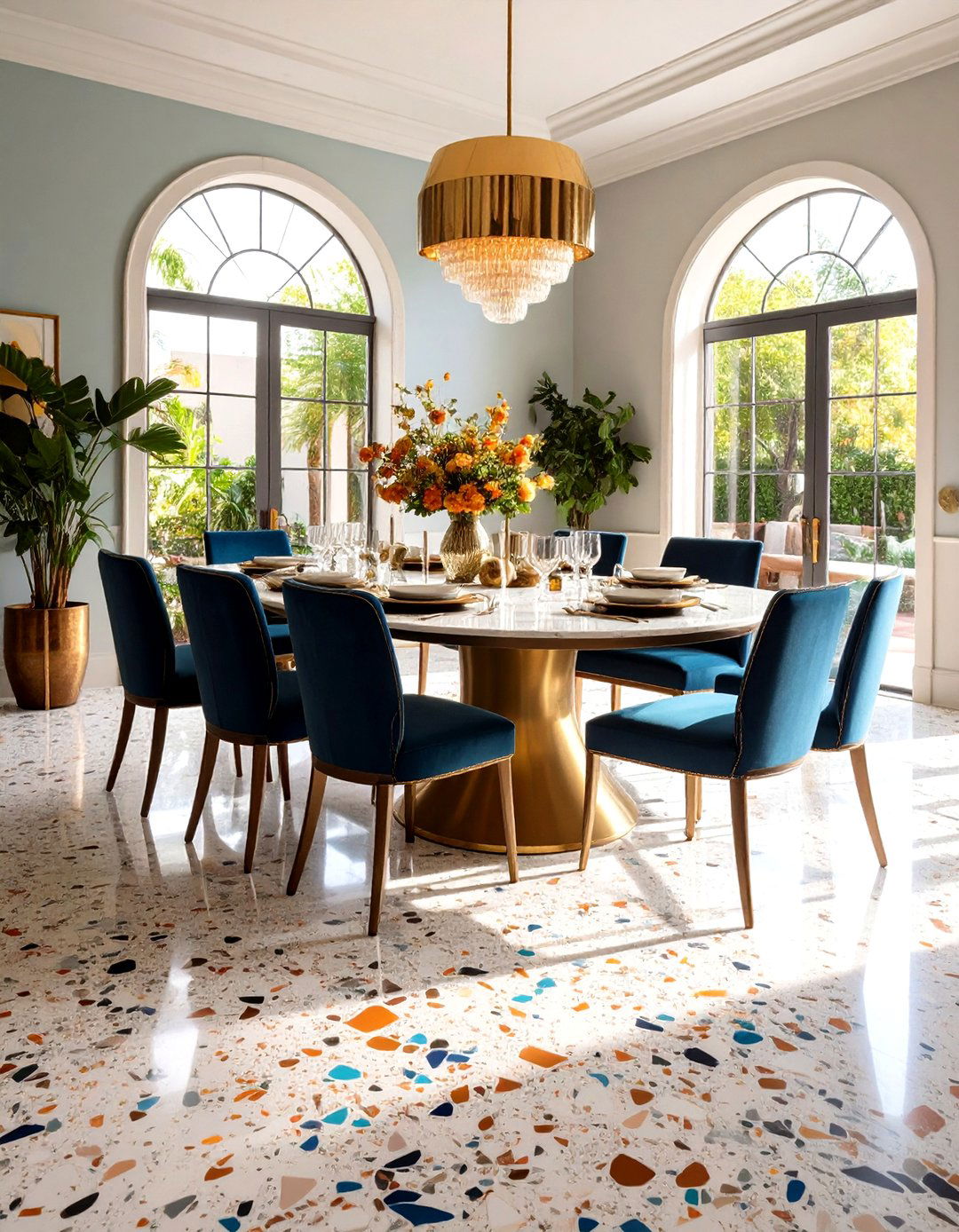
Looking for durability with design pedigree? Terrazzo flooring sprinkled with contrasting marble chips recalls grand Deco lobbies yet withstands modern foot traffic and spills. New prefab tiles make installation less daunting than poured aggregate. Select neutral chips flecked with metallic flakes for subtle sparkle, or commit to bold emerald and onyx fragments under a glass-topped dining table for maximum visibility.
19. Frosted-Glass Panel Doors Offer Subtle Glam
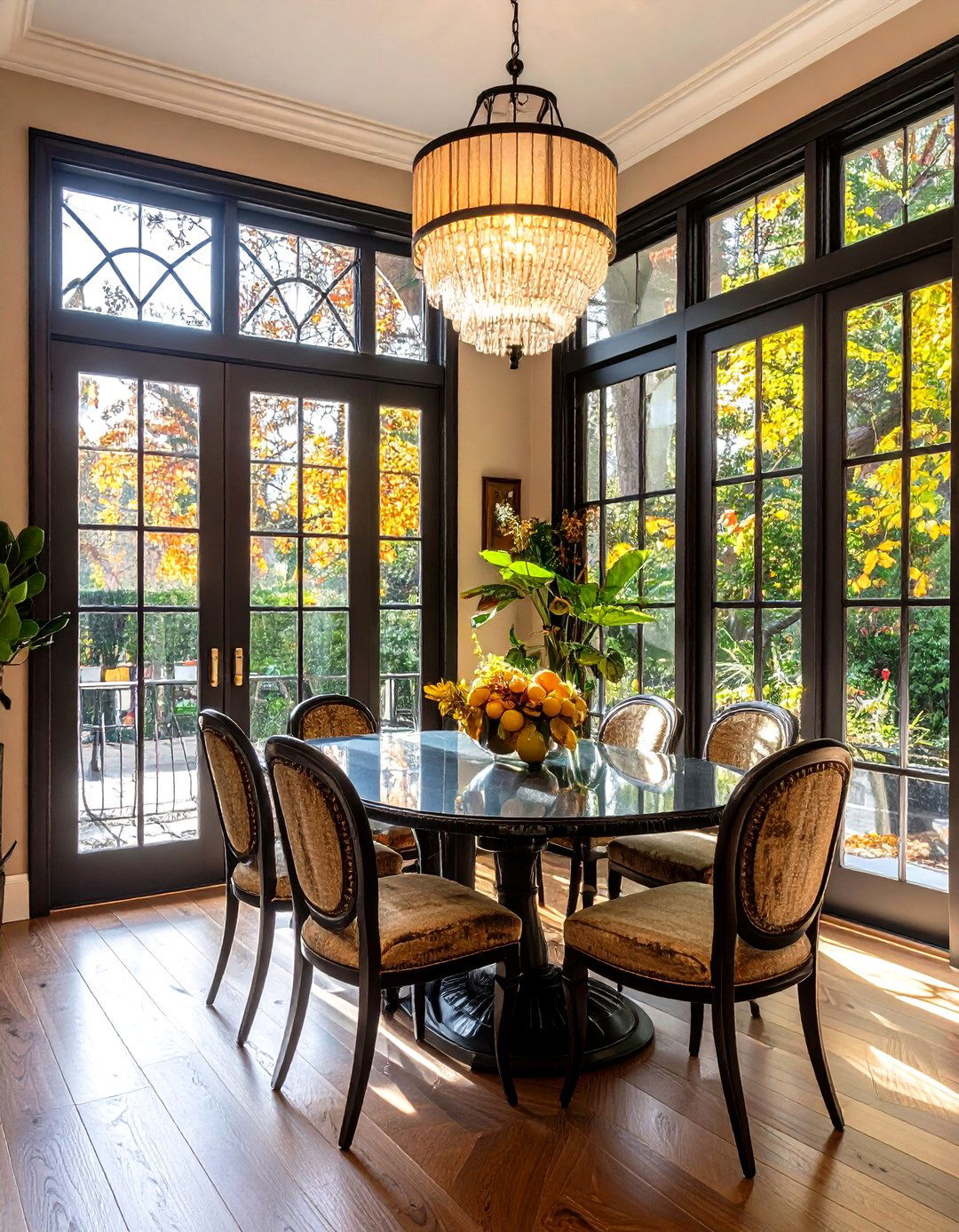
Replace solid dining-room doors with frosted or reeded glass framed in slim black metal. The translucent surface diffuses light between spaces while maintaining privacy, and its vertical grooves nod to the fluting seen on Deco columns. For cohesion, repeat the texture on a nearby bar cabinet or pendant shade. Hardware in unlacquered brass will patinate gracefully, adding depth over time.
20. Arched Doorway Frames Add Cinematic Flair

Unlike hard rectangles, an arched opening whispers Art Deco romance. If structural walls prevent true arches, faux the look with curved plaster trim or a half-circle paint treatment that crowns the doorway. The shape immediately softens geometric furniture, and when paired with a matching arched mirror across the room, creates a vista that feels both grand and welcoming.
21. Marble Fireplace Surround Anchors the Scheme
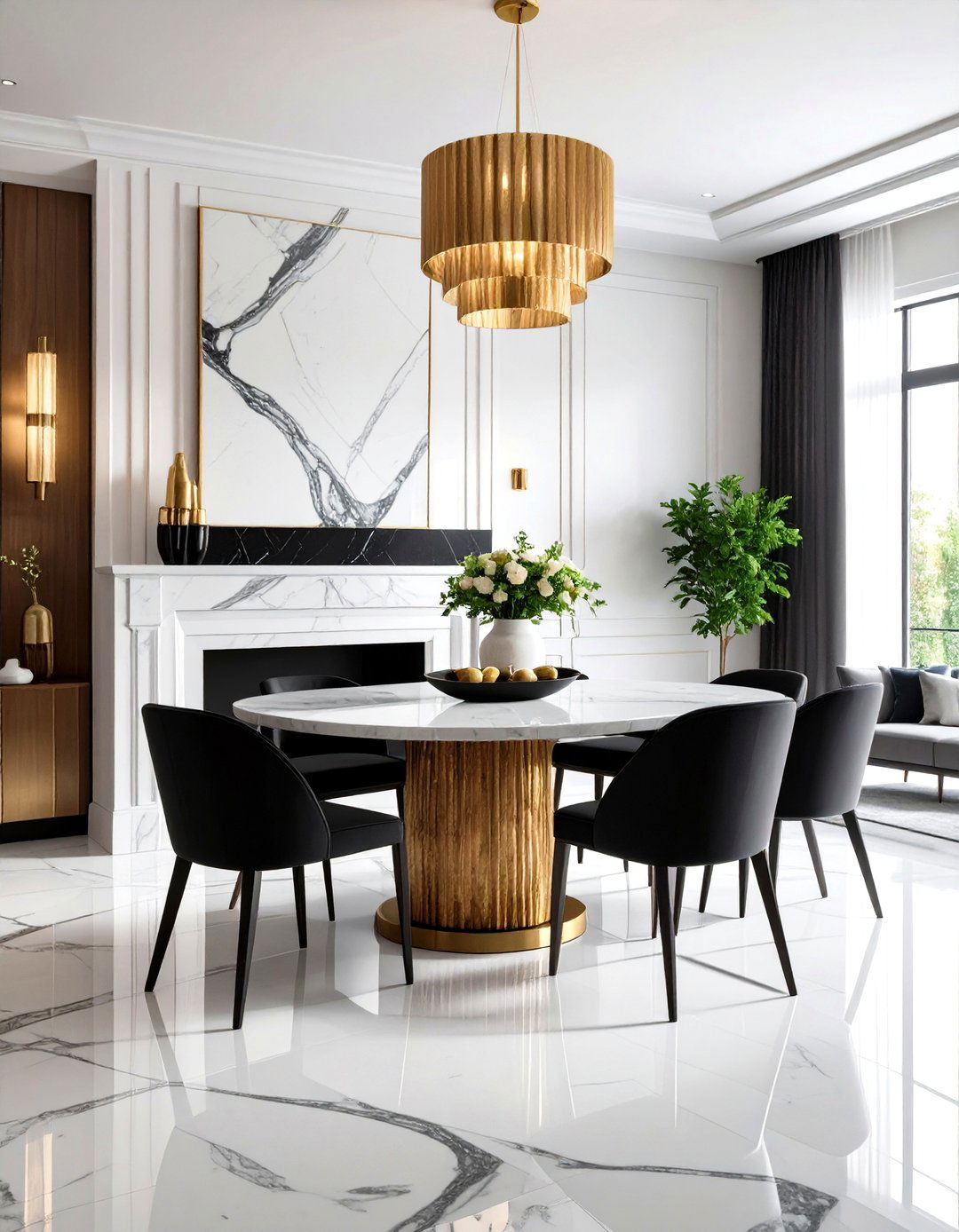
For homes lucky enough to feature a dining-room hearth, cladding it in black-or-white striped marble evokes the drama of Manhattan’s Chrysler Building lobby. Keep mantels minimal—perhaps just a single bronze sculpture—so the stone’s veining remains the hero. Install low-profile gas inserts if wood storage is an issue; the flicker still enlivens dinners without added chores.
22. High-Gloss Paint Finishes Reflect Light Playfully
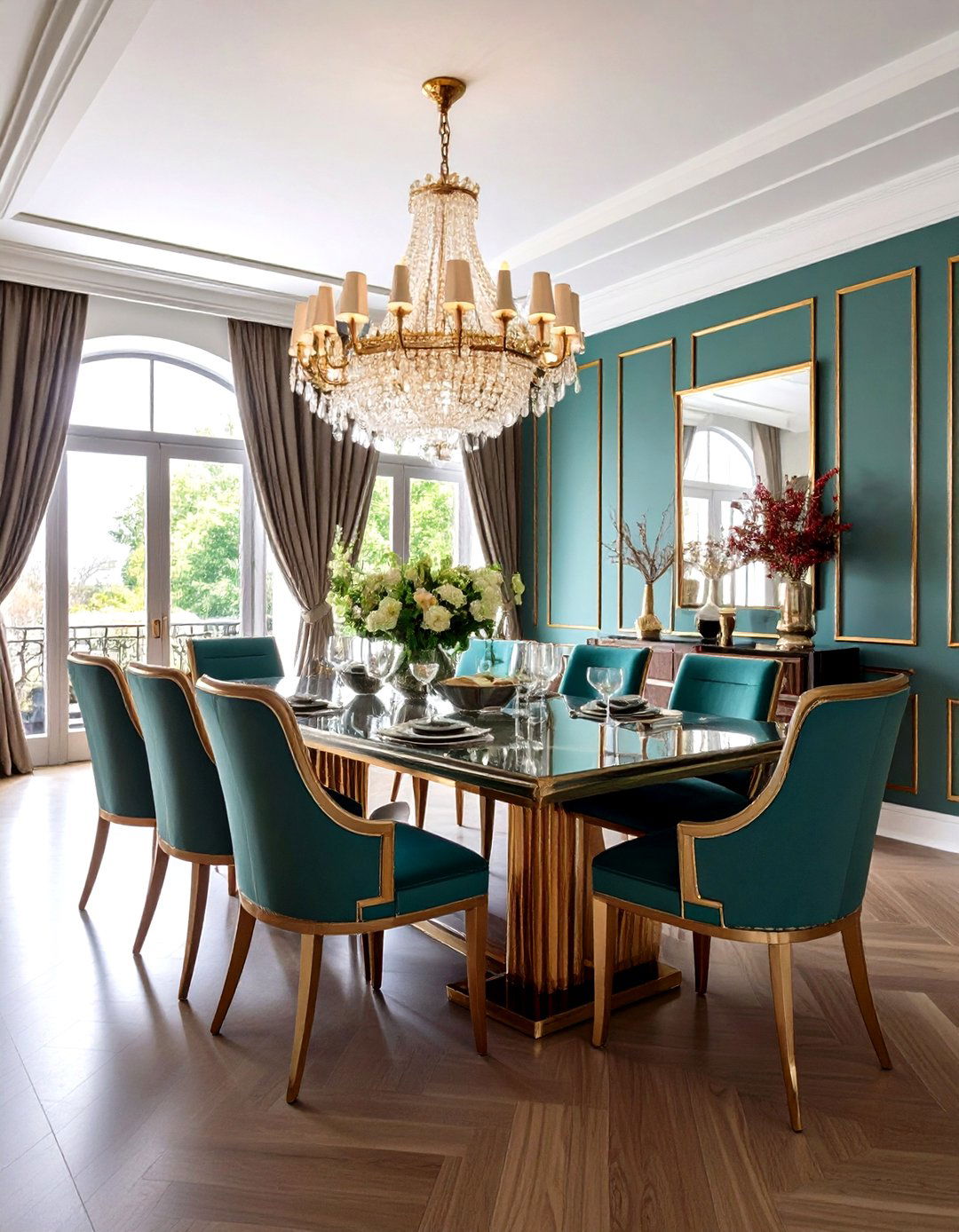
Looking, perhaps, for an attainable weekend update? High-gloss enamel paint turns even builder-grade millwork into a Deco-worthy focal point. Apply it to chair rails, door casings, or the inside of built-in shelves. Because shine magnifies imperfections, sand thoroughly and use a quality primer. The payoff is mirror-like surfaces that amplify ambient light, making smaller dining rooms appear larger.
23. Angular Sideboard Offers Sleek Storage
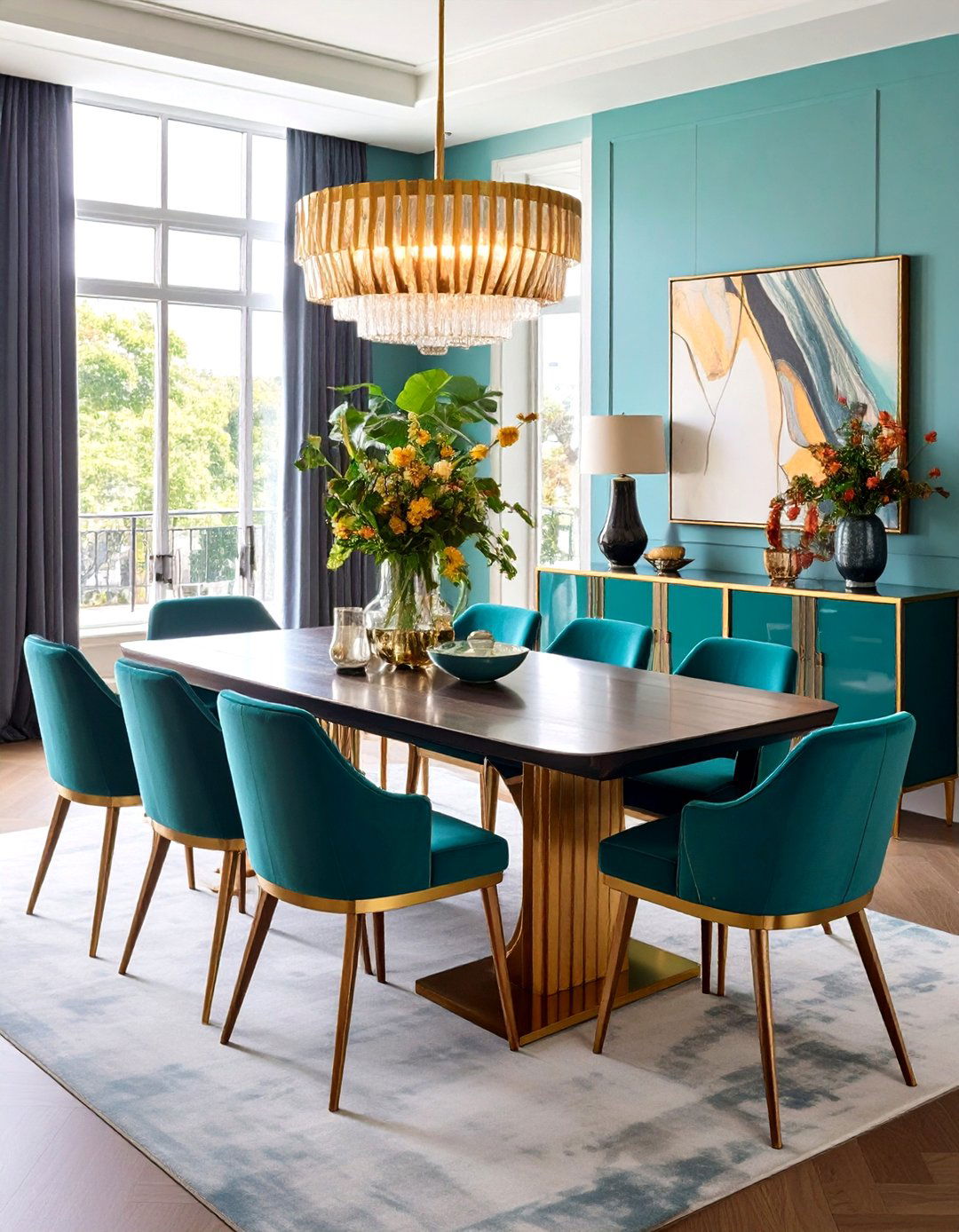
Unlike ornate buffets, an angular sideboard with waterfall edges keeps serving pieces at hand without visual clutter. Select one featuring slim brass pulls arranged in a stepped pattern for a subtle nod to skyscraper elevations. Inside, adjustable shelves adapt to platters of varying heights, ensuring practicality matches style. Top with a single oversized vase rather than many tchotchkes to preserve its clean lines.
24. Sustainable Deco Materials Update Tradition
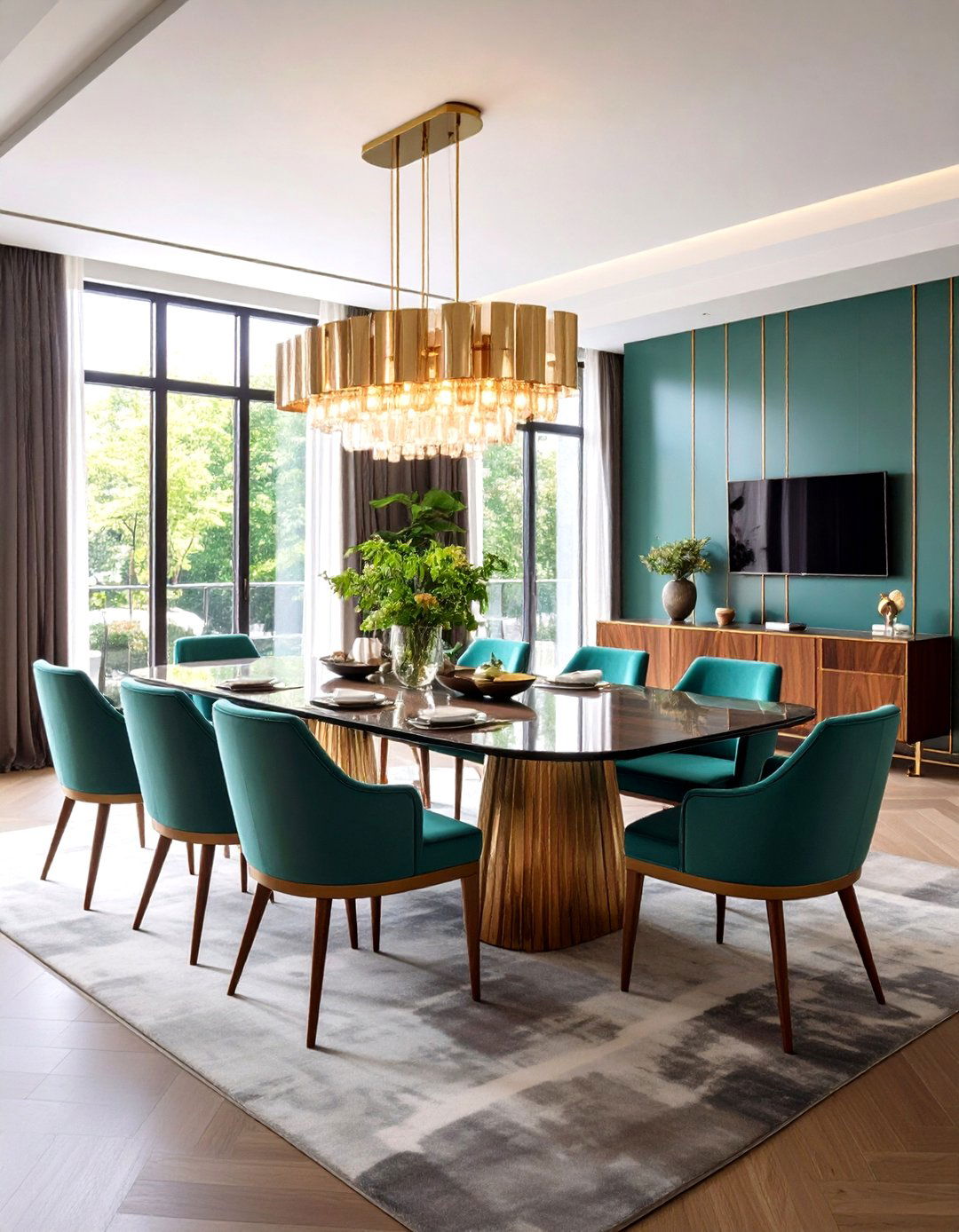
Despite Deco’s opulent roots, today’s eco-minded homeowners can achieve the look with FSC-certified walnut, recycled-glass tiles, and low-VOC lacquers, marrying glamour with responsible sourcing. Designers note that mixing vintage furniture—already carbon neutral—with new planet-friendly pieces tells a richer story than buying everything new.
decorilla.com
Highlight your green choices in subtle ways, such as small plaques inside drawers, so guests appreciate the modern consciousness behind the classic style.
25. Vintage-Meets-Modern Mix Keeps the Look Fresh
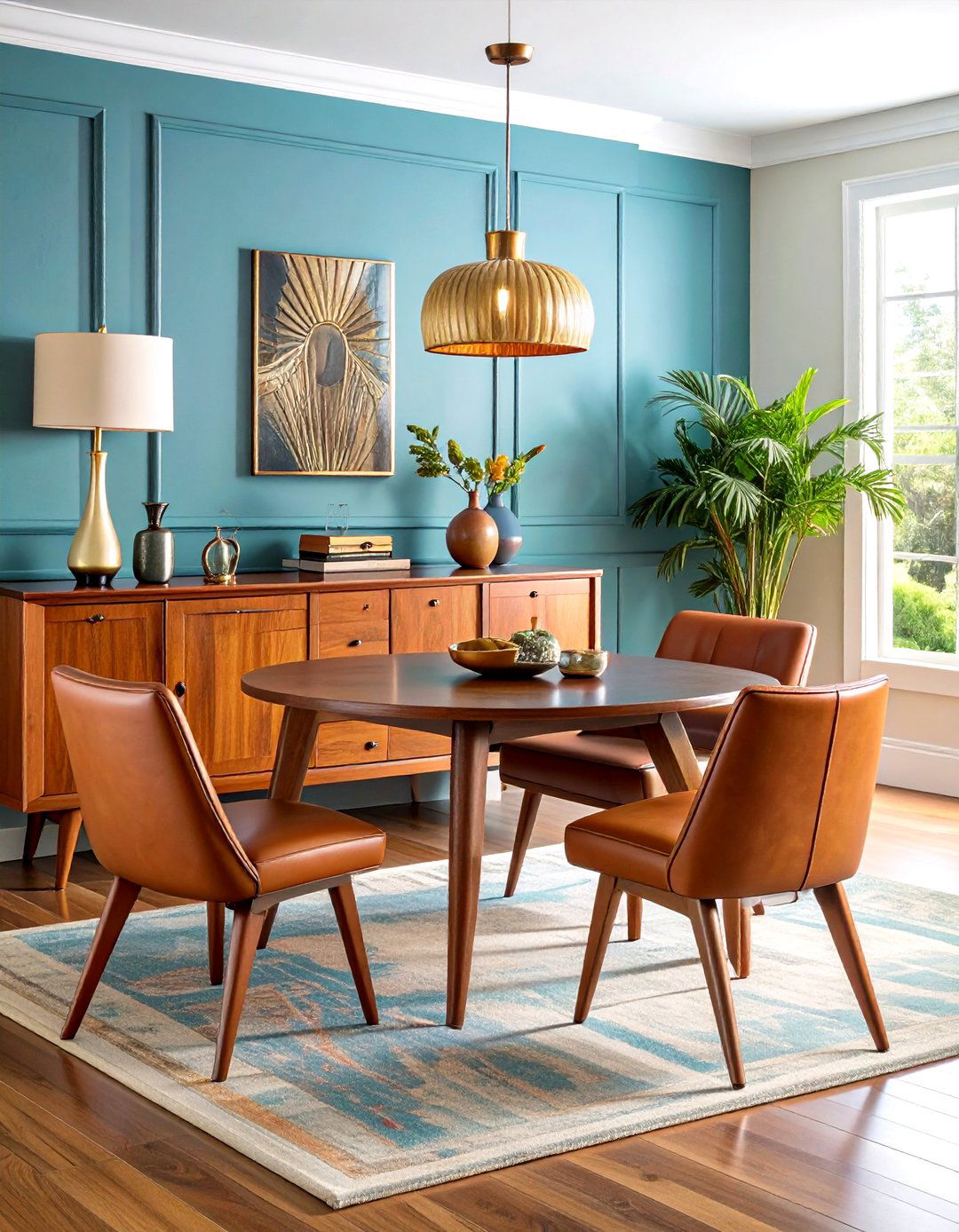
Finally, an Art Deco dining room lives and breathes when antique finds mingle with contemporary accents. Pair a 1930s waterfall credenza with minimalist leather chairs, or flank a sleek marble table with reupholstered vintage club chairs. This tension prevents the space from feeling like a museum set and allows personal taste to shine. Routinely edit accessories so each piece—old or new—retains breathing room and intention.
Conclusion:
From geometric ceilings to sustainable materials, these Art Deco dining room ideas share one aim: transforming everyday meals into moments of cinematic glamour. Whether you commit to a lacquered table or simply roll in a curved bar cart, each addition layers symmetry, sheen, and bold pattern that define the style’s allure. Let your dining room tell a story of past-meets-present sophistication—proof that good design, like lively conversation, never goes out of style.


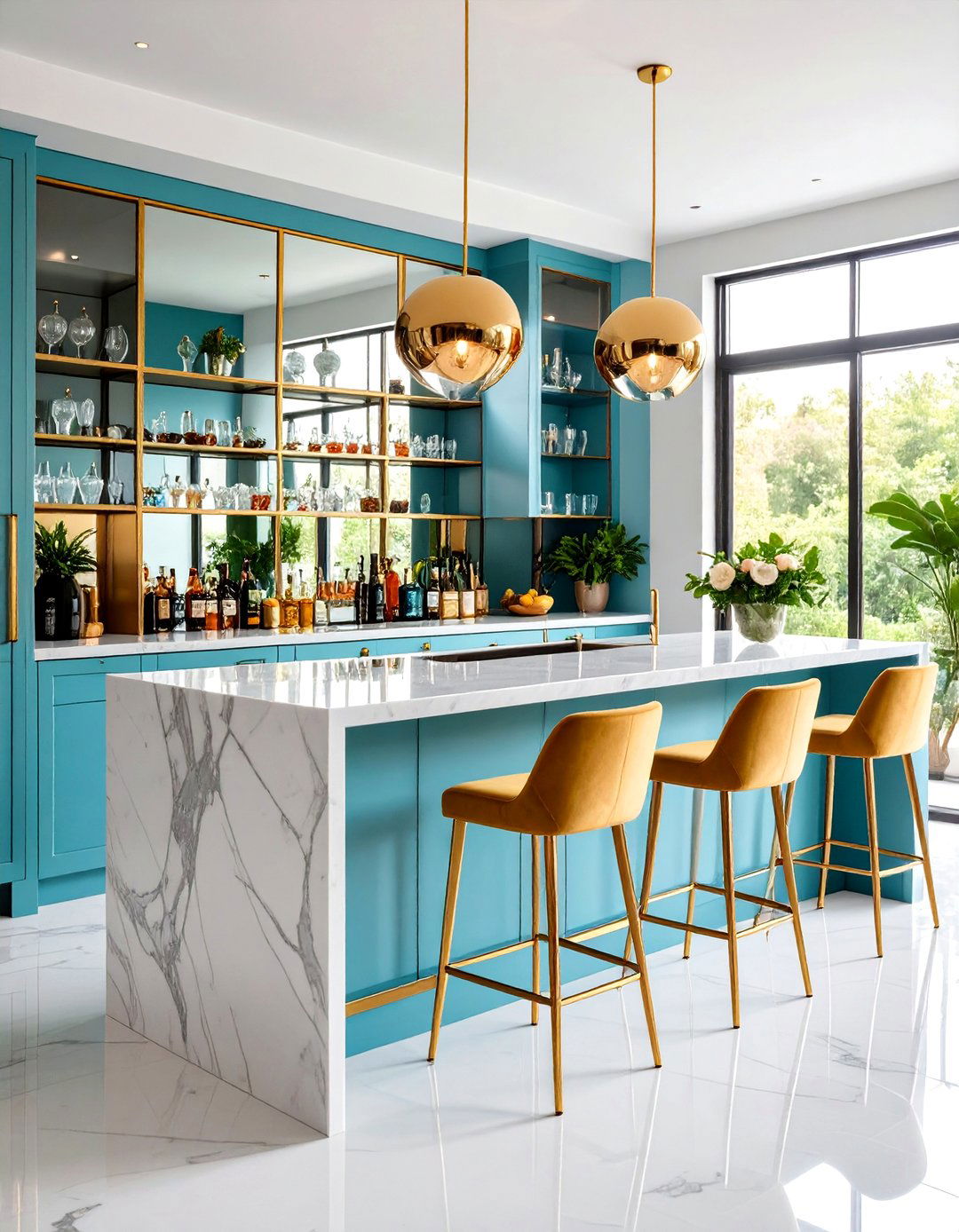
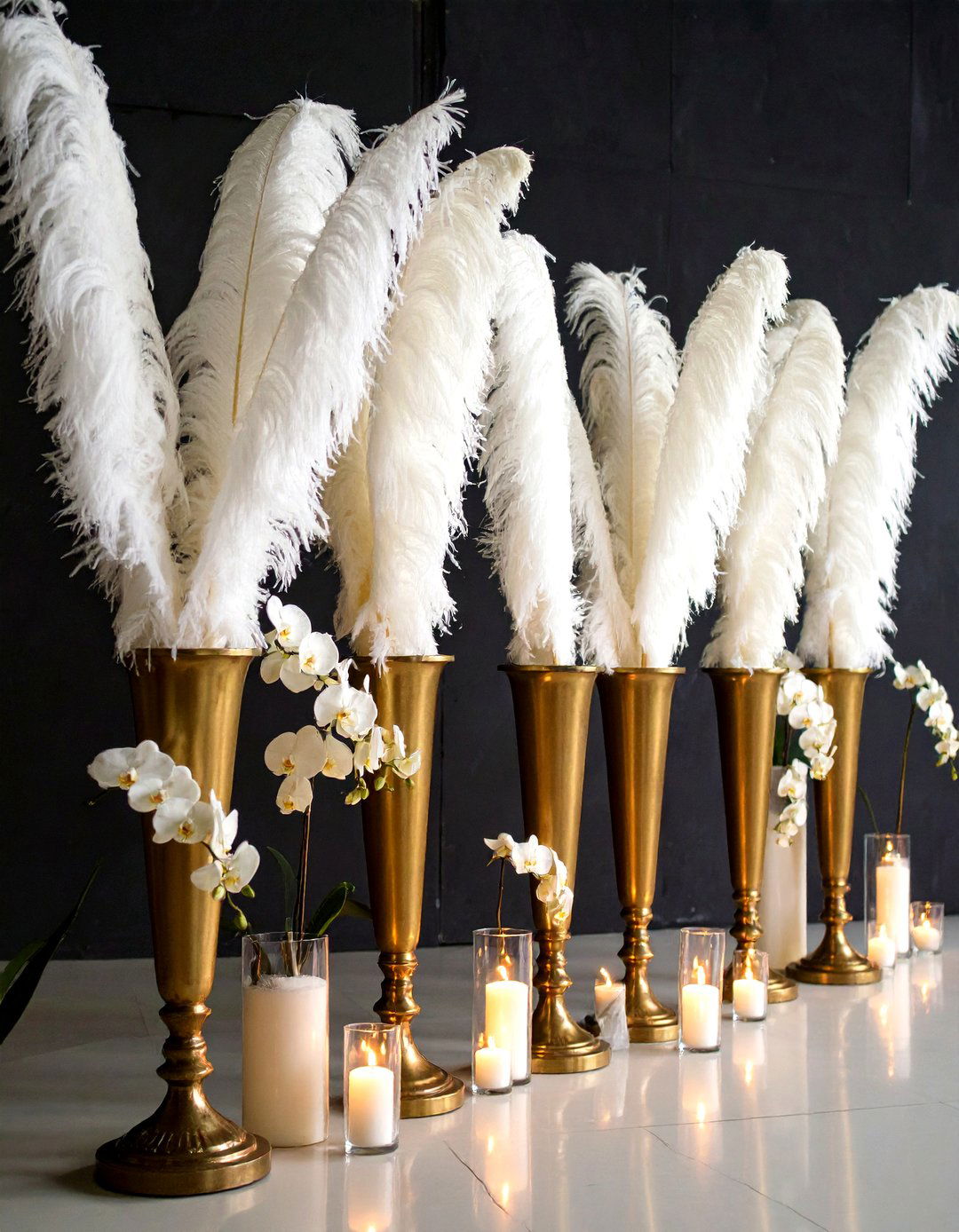

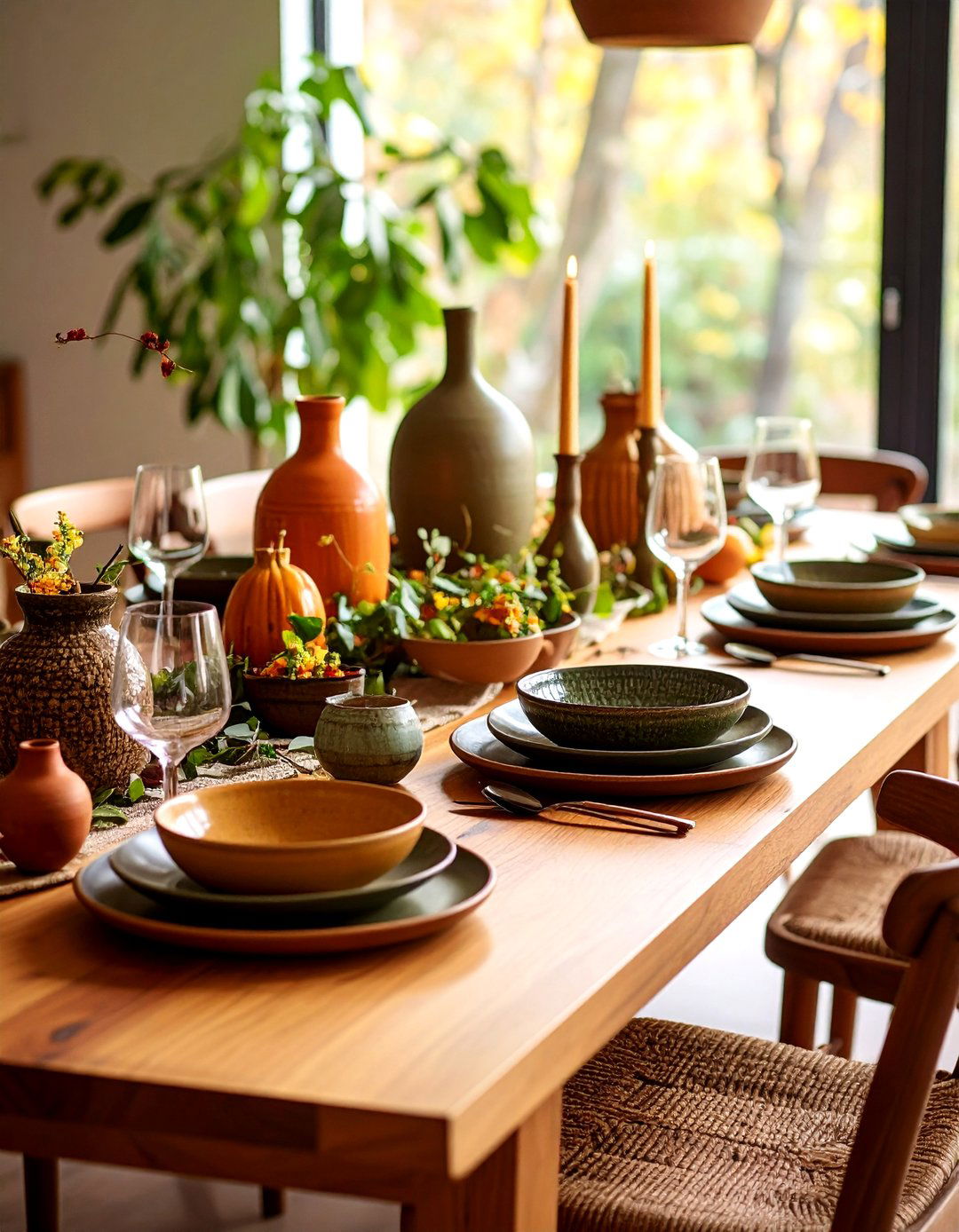
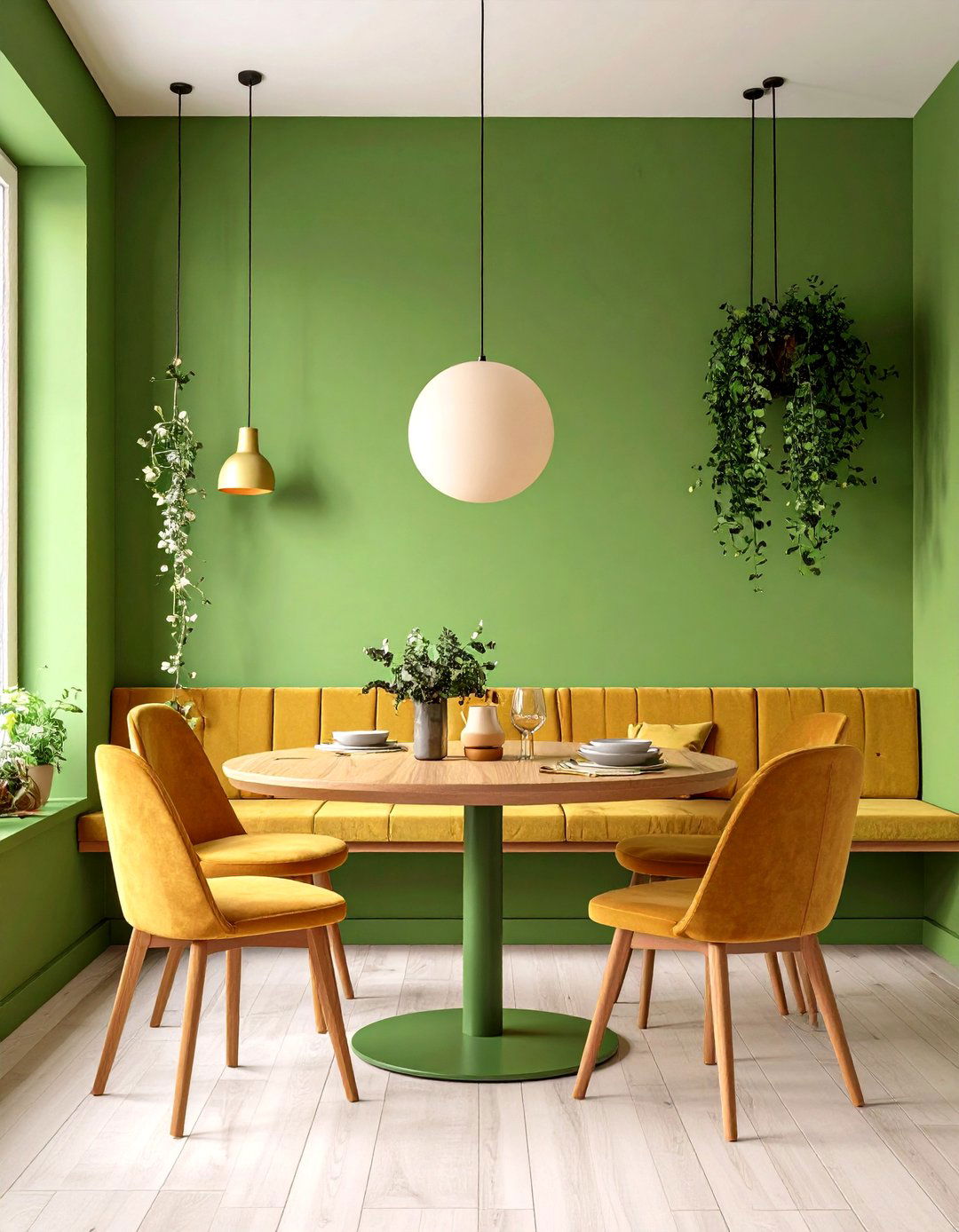
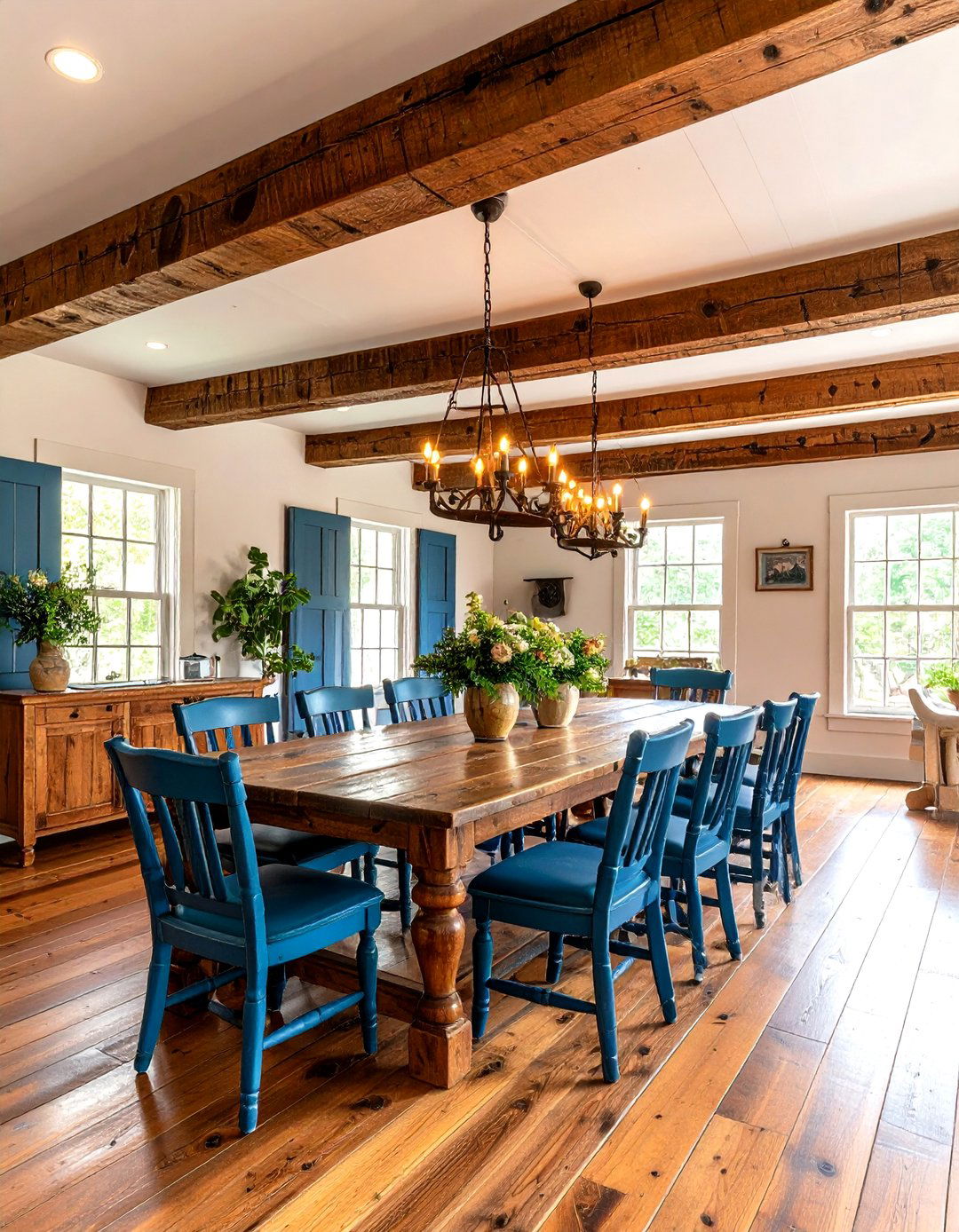
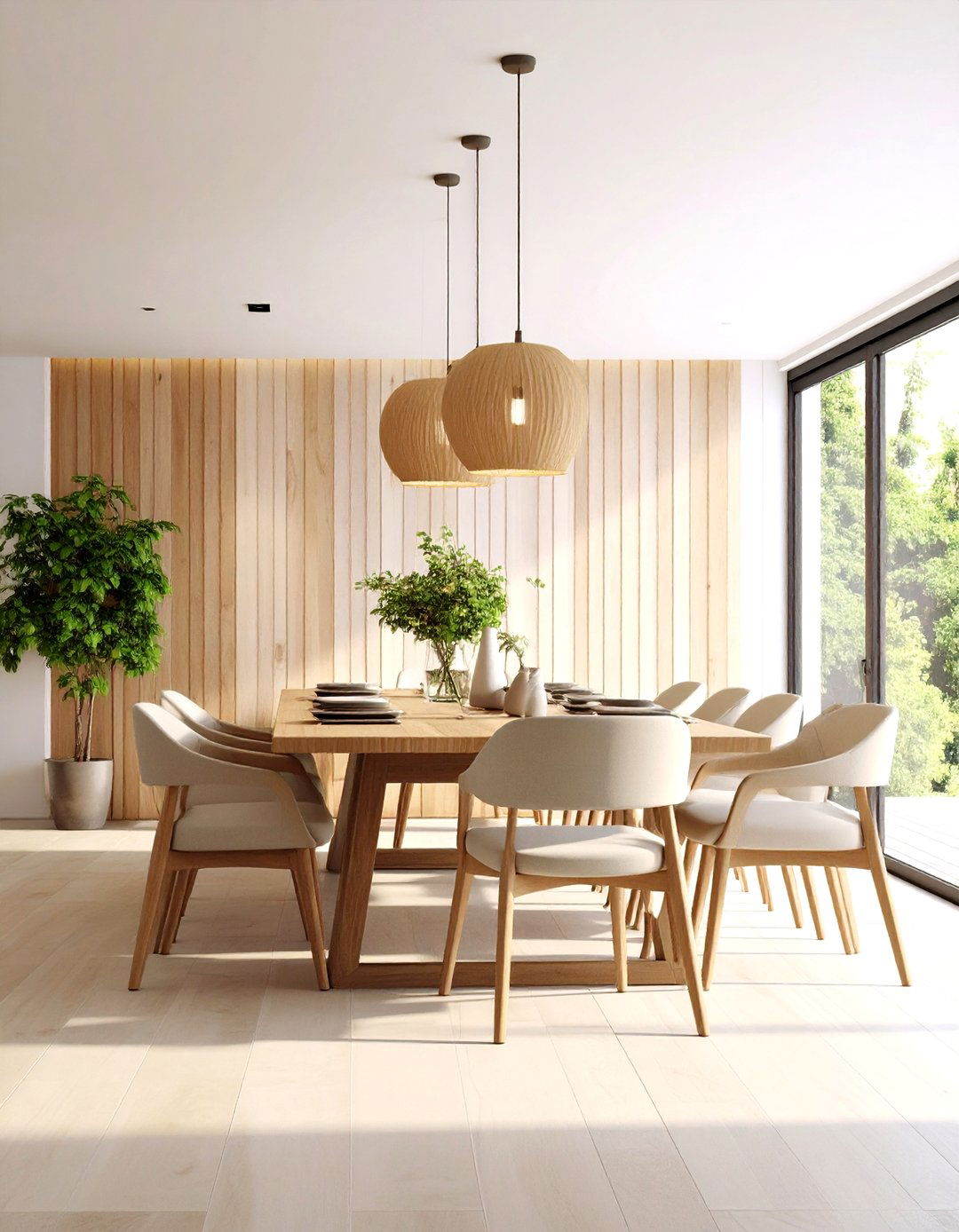

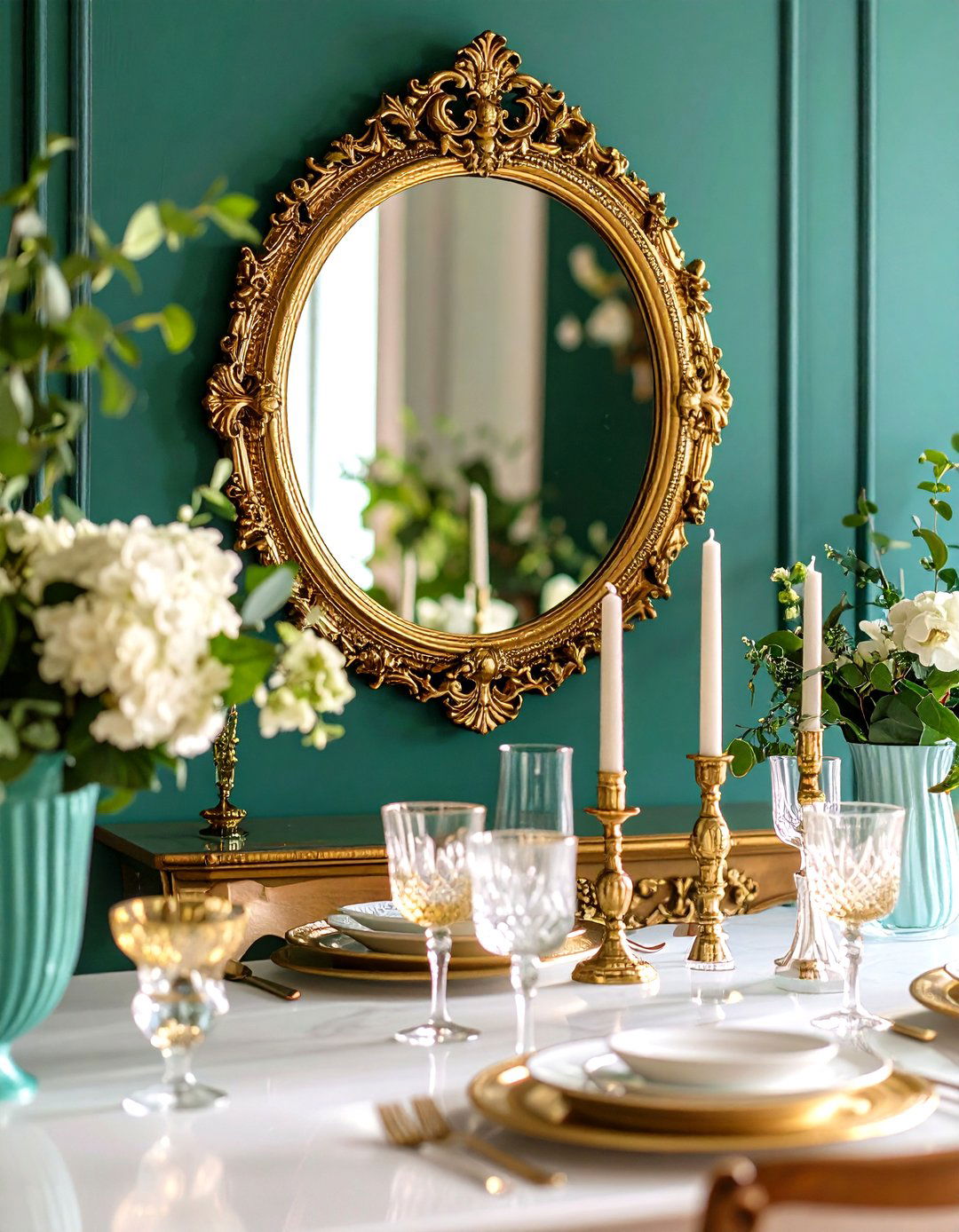
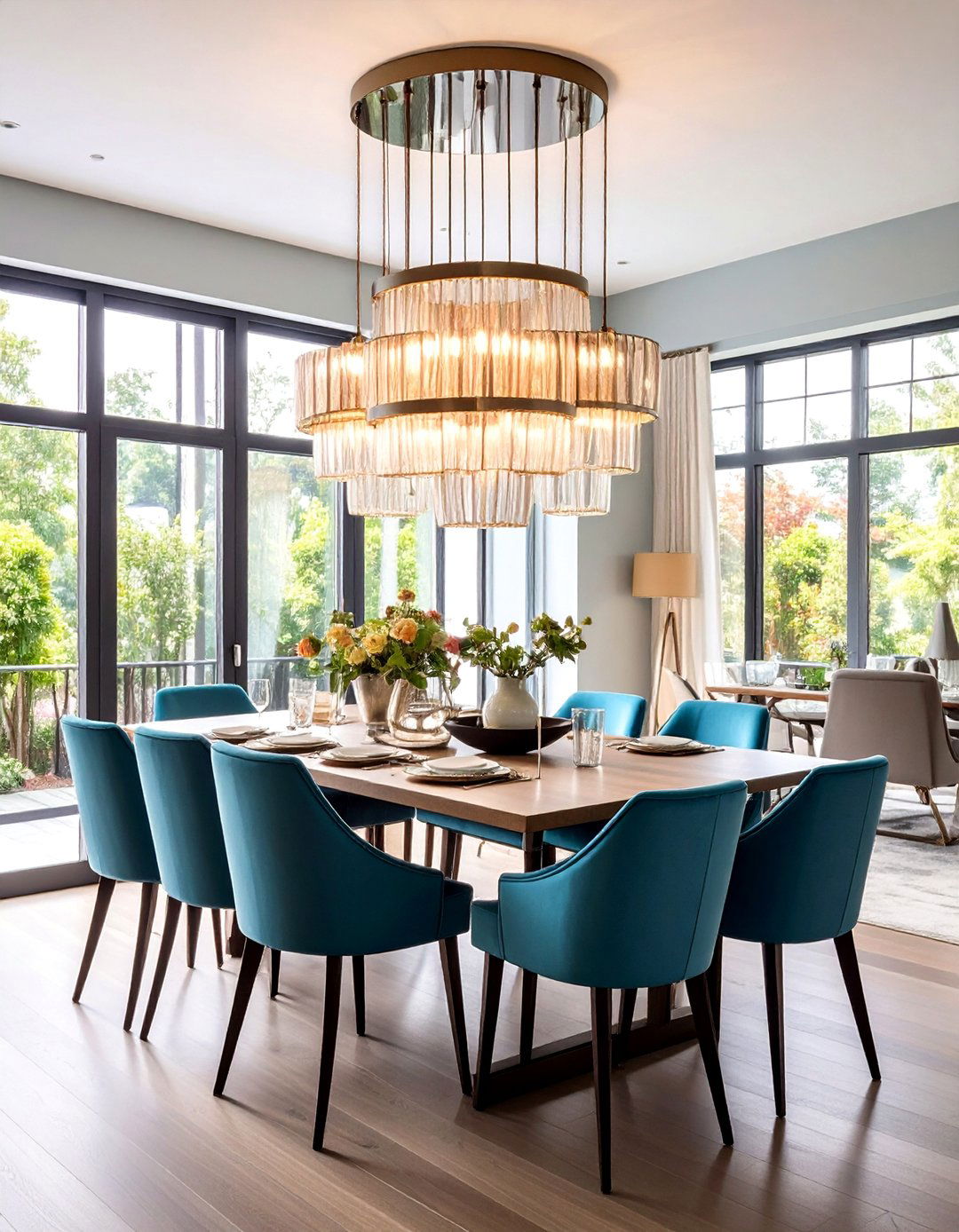
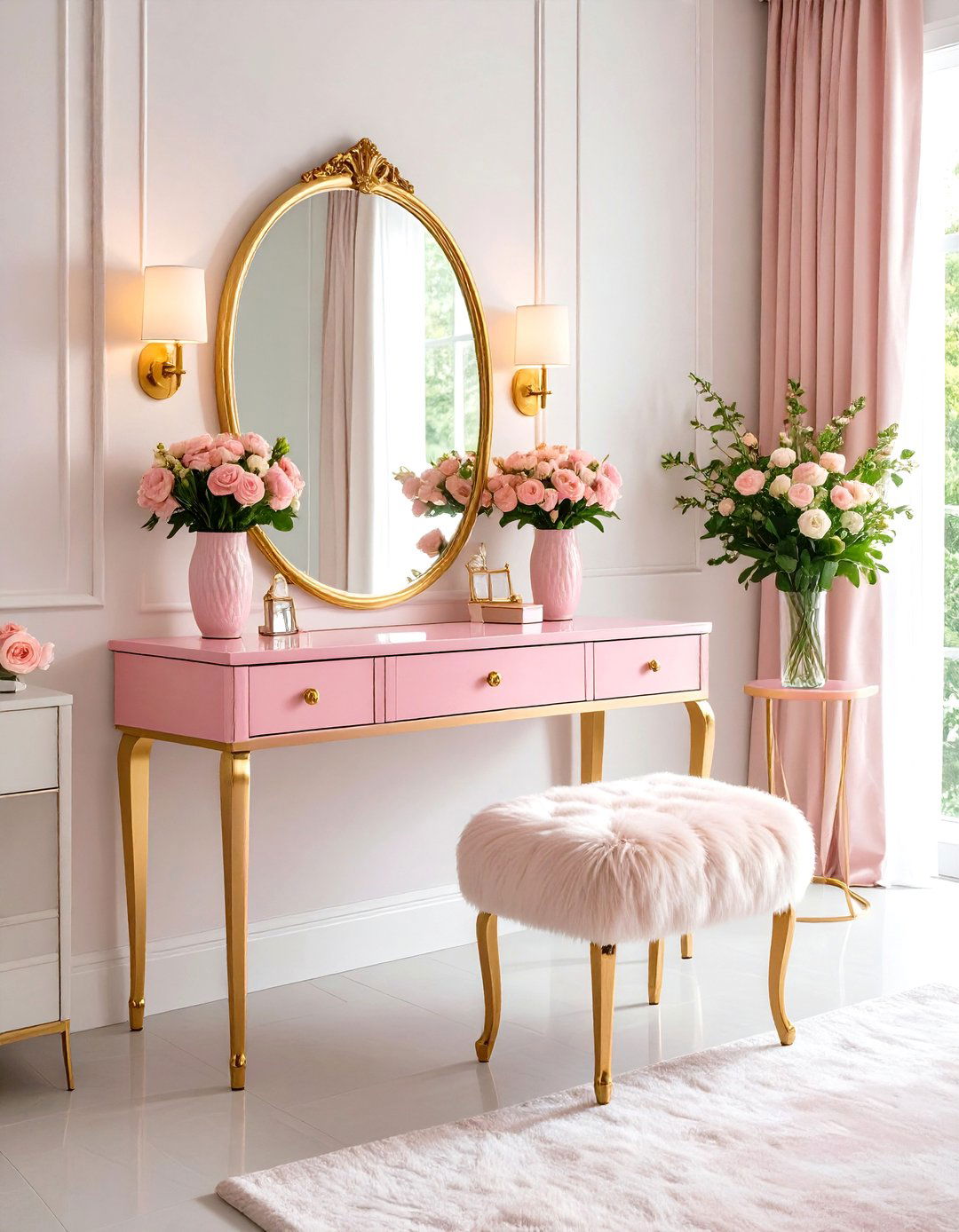
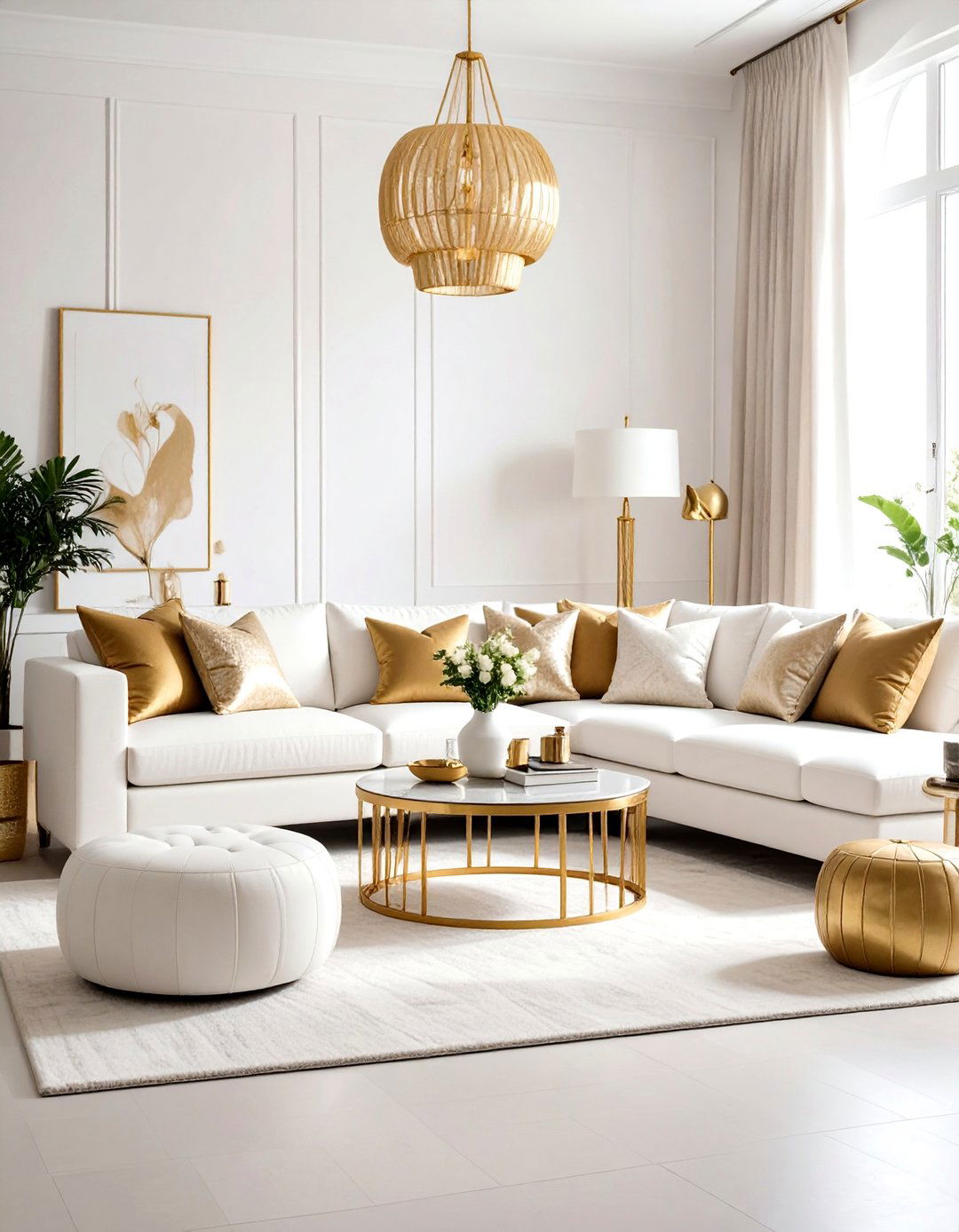

Leave a Reply